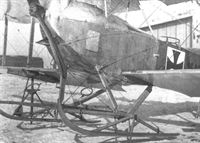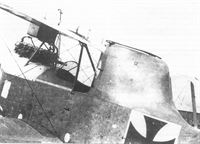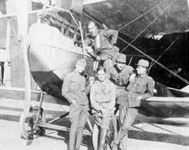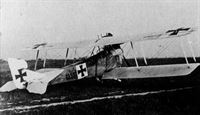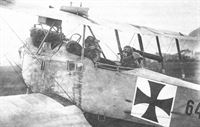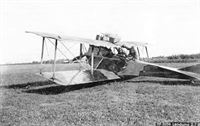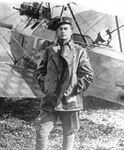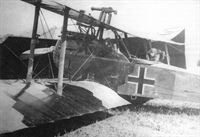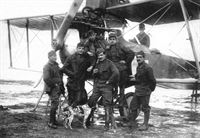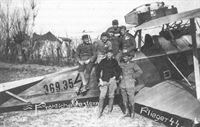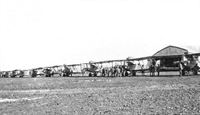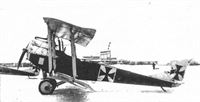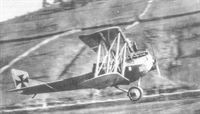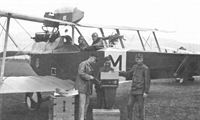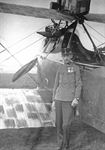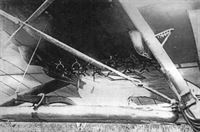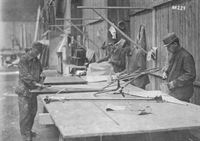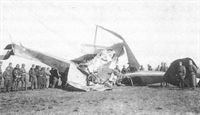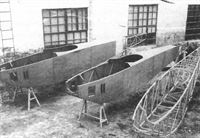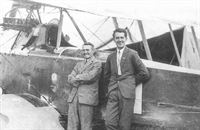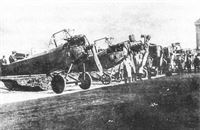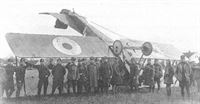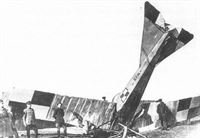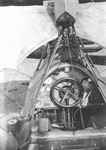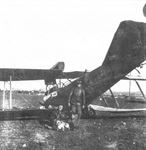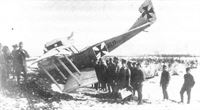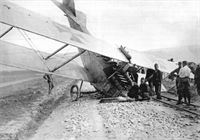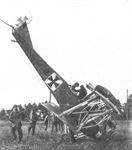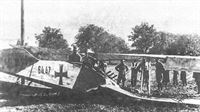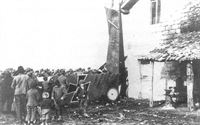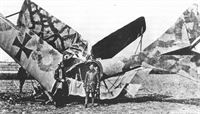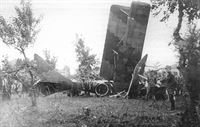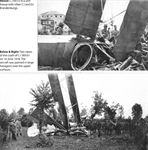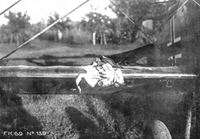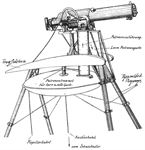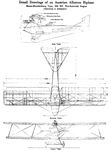
Описание
Страна: Германия
Год: 1915
Фронтовой самолет
Варианты
- Hansa-Brandenburg - B.I / FD / LDD - 1914 - Германия
- Hansa-Brandenburg - D - 1914 - Германия
- Hansa-Brandenburg - C.I - 1915 - Германия
- В.Кондратьев Самолеты первой мировой войны
- А.Александров, Г.Петров Крылатые пленники России
- C.Owers Hansa-Brandenburg Aircraft of WWI Vol.1: Landplanes (A Centennial Perspective on Great War Airplanes 17)
- M.Dusing German Aviation Industry in WWI. Volume 1 (A Centennial Perspective on Great War Airplanes 84)
- P.Grosz, G.Haddow, P.Shiemer Austro-Hungarian Army Aircraft of World War One (Flying Machines)
- E.Hauke, W.Schroeder, B.Totschinger Die Flugzeuge der k.u.k. Luftfahrtruppe und Seeflieger 1914-1918
-
C.Owers - Hansa-Brandenburg Aircraft of WWI. Volume 1 - Landplanes /Centennial Perspective/ (17)
Brandenburg DD prototype as built
-
C.Owers - Hansa-Brandenburg Aircraft of WWI. Volume 1 - Landplanes /Centennial Perspective/ (17)
Brandenburg DD 05.07, the prototype after the over-wing gun ring was removed and the serial was painted on after purchase by Flars.
-
P.Grosz, G.Haddow, P.Shiemer - Austro-Hungarian Army Aircraft of World War One /Flying Machines/
Brandenburg C.I(Ph) 26.09, Flik 23
-
E.Hauke, W.Schroeder, B.Totschinger - Die Flugzeuge der k.u.k. Luftfahrtruppe und Seeflieger 1914-1918
Hansa-Brandenburg C I 26.17 Versuch mit MG-Turm (erste Ausführung)
-
C.Owers - Hansa-Brandenburg Aircraft of WWI. Volume 1 - Landplanes /Centennial Perspective/ (17)
Brandenburg C.I 26.17 with initial fairing for observer evaluated at Flik 13 in August 1916.
-
C.Owers - Hansa-Brandenburg Aircraft of WWI. Volume 1 - Landplanes /Centennial Perspective/ (17)
Brandenburg C.I 26.17 with enlarged fairing for observer evaluated at Flik 13 in August 1916. The fairing was extended to reduce turbulence over the tail.
-
P.Grosz, G.Haddow, P.Shiemer - Austro-Hungarian Army Aircraft of World War One /Flying Machines/
Brandenburg C.I(Ph) 26.17, Flik 7
-
C.Owers - Hansa-Brandenburg Aircraft of WWI. Volume 1 - Landplanes /Centennial Perspective/ (17)
Brandenburg C.I 26.63 of Flik 20. On 19 June 1917 Korp. Skiakovitz and Ltn. Dechant in 26.63 were part of a formation of 3 aircraft attacked by 5 Nieuports. They downed one of the attackers but 26.63 was forced down with a damaged engine.
-
P.Grosz, G.Haddow, P.Shiemer - Austro-Hungarian Army Aircraft of World War One /Flying Machines/
Brandenburg C.I(Ph) 27.83, Flik 35
-
E.Hauke, W.Schroeder, B.Totschinger - Die Flugzeuge der k.u.k. Luftfahrtruppe und Seeflieger 1914-1918
Hansa-Brandenburg C I 29.09 Flik 19 Sommer 1917
-
E.Hauke, W.Schroeder, B.Totschinger - Die Flugzeuge der k.u.k. Luftfahrtruppe und Seeflieger 1914-1918
Hansa-Brandenburg C I 29.54 Flik 16 Juli 1917
-
C.Owers - Hansa-Brandenburg Aircraft of WWI. Volume 1 - Landplanes /Centennial Perspective/ (17)
Brandenburg C.I 29.54 of Flik 23. The red fuselage band was the Flik marking.
-
P.Grosz, G.Haddow, P.Shiemer - Austro-Hungarian Army Aircraft of World War One /Flying Machines/
Brandenburg C.I(Ph) 29.63, Flik 19/D
-
C.Owers - Hansa-Brandenburg Aircraft of WWI. Volume 1 - Landplanes /Centennial Perspective/ (17)
Brandenburg C.I(Ph) 29.64 flown by Hptm. Adolf Heyrowski, CO of Flik 19D, July 1918. The fuselage bands were the Flik marking. Heyrowski scored at least 5 victories in 29.64 with various observers.
-
E.Hauke, W.Schroeder, B.Totschinger - Die Flugzeuge der k.u.k. Luftfahrtruppe und Seeflieger 1914-1918
Hansa-Brandenburg C I 29.64 Flik 19 Ghirano Jänner 1918
-
C.Owers - Hansa-Brandenburg Aircraft of WWI. Volume 1 - Landplanes /Centennial Perspective/ (17)
Brandenburg C.I 229.04 in postwar Yugoslavian service.
-
P.Grosz, G.Haddow, P.Shiemer - Austro-Hungarian Army Aircraft of World War One /Flying Machines/
Brandenburg C.I(Ph) 329.08, Flik 101/G
-
C.Owers - Hansa-Brandenburg Aircraft of WWI. Volume 1 - Landplanes /Centennial Perspective/ (17)
Brandenburg C.I(Ph) 329.50 of Flik 265, Summer of 1918.
-
E.Hauke, W.Schroeder, B.Totschinger - Die Flugzeuge der k.u.k. Luftfahrtruppe und Seeflieger 1914-1918
Hansa-Brandenburg C I 329.50 Flik 26 S Piavefront Sommer 1918
-
P.Grosz, G.Haddow, P.Shiemer - Austro-Hungarian Army Aircraft of World War One /Flying Machines/
Brandenburg C.I(Ph) 429.22, Flars
-
E.Hauke, W.Schroeder, B.Totschinger - Die Flugzeuge der k.u.k. Luftfahrtruppe und Seeflieger 1914-1918
Hansa-Brandenburg C I 429.29
-
C.Owers - Hansa-Brandenburg Aircraft of WWI. Volume 1 - Landplanes /Centennial Perspective/ (17)
Brandenburg C.I(Ph) 429.29 seen at Aspern, Summer 1918.
-
C.Owers - Hansa-Brandenburg Aircraft of WWI. Volume 1 - Landplanes /Centennial Perspective/ (17)
Brandenburg C.I(Ph) 429.29 seen at Aspern, Summer 1918. This alternative depiction is based on research on the paint on the Aviatik D.I in the Vienna Technical Museum. Chemical analysis indicated the original colors may have been light and dark gray as shown here, which aged to the tan and green shown above. However, no contemporary evidence confirms the grays and the tan and green seen on the existing aircraft seem more likely to be the original colors.
-
E.Hauke, W.Schroeder, B.Totschinger - Die Flugzeuge der k.u.k. Luftfahrtruppe und Seeflieger 1914-1918
Hansa-Brandenburg C I 429.36 Andreas Dombrowsky Flik 57 Rb San Godega di Urbano Herbst 1918
-
C.Owers - Hansa-Brandenburg Aircraft of WWI. Volume 1 - Landplanes /Centennial Perspective/ (17)
Brandenburg C.I(U) 429.46 at Wiener-Neustadt, Summer 1918.
-
C.Owers - Hansa-Brandenburg Aircraft of WWI. Volume 1 - Landplanes /Centennial Perspective/ (17)
Brandenburg C.I(U) 429.46 in postwar Polish service; additional camouflage has been applied.
-
C.Owers - Hansa-Brandenburg Aircraft of WWI. Volume 1 - Landplanes /Centennial Perspective/ (17)
Brandenburg C.I(U) 429.46 in postwar Polish service. After crashing, the aircraft was given a new, Polish-built fuselage in January 1919 and then served with Nos. 9 & 5 Squadrons in 1920/21.
-
P.Grosz, G.Haddow, P.Shiemer - Austro-Hungarian Army Aircraft of World War One /Flying Machines/
Brandenburg C.I 61.64., Flik 6
-
E.Hauke, W.Schroeder, B.Totschinger - Die Flugzeuge der k.u.k. Luftfahrtruppe und Seeflieger 1914-1918
Hansa-Brandenburg C I 61.64 Julius Arigi Flik 6 Skutari August 1916
-
C.Owers - Hansa-Brandenburg Aircraft of WWI. Volume 1 - Landplanes /Centennial Perspective/ (17)
Brandenburg-built C.I 61.70 was part of the only C.I series with unbalanced rudder; the slanted Mercedes radiator was only fitted to Brandenburg-built C.Is.
-
C.Owers - Hansa-Brandenburg Aircraft of WWI. Volume 1 - Landplanes /Centennial Perspective/ (17)
Brandenburg C.I 63.53 at Aspern, July 1916. Part of the only batch of C.Is powered by the 160 hp Mercedes D.III, this aircraft was shot down by Russian ground fire on January 11, 1917. Presentation of the serial as "6353." instead of "63.53" is distinctive.
-
E.Hauke, W.Schroeder, B.Totschinger - Die Flugzeuge der k.u.k. Luftfahrtruppe und Seeflieger 1914-1918
Hansa-Brandenburg C I 64.14 Raoul Stojsavljevic Flik 16 D Villach Sommer 1916
-
C.Owers - Hansa-Brandenburg Aircraft of WWI. Volume 1 - Landplanes /Centennial Perspective/ (17)
Brandenburg C.I(U) 64.17 SVETOVAR.
-
C.Owers - Hansa-Brandenburg Aircraft of WWI. Volume 1 - Landplanes /Centennial Perspective/ (17)
Brandenburg C.I(U) 64.20; the white background of the fuselage insignia has been scrapped away.
-
P.Grosz, G.Haddow, P.Shiemer - Austro-Hungarian Army Aircraft of World War One /Flying Machines/
Brandenburg C.I(U) 64.22, Flik 13
-
C.Owers - Hansa-Brandenburg Aircraft of WWI. Volume 1 - Landplanes /Centennial Perspective/ (17)
Brandenburg C.I(U) 64.22 VICI of Flik 13.
-
В.Кондратьев - Самолеты первой мировой войны
"Ганза-Бранденбург" С-I, 13 эскадрилья ВВС Австро-Венгрии, август 1916г.
-
C.Owers - Hansa-Brandenburg Aircraft of WWI. Volume 1 - Landplanes /Centennial Perspective/ (17)
Brandenburg C.I 64.65 in postwar Polish service.
-
E.Hauke, W.Schroeder, B.Totschinger - Die Flugzeuge der k.u.k. Luftfahrtruppe und Seeflieger 1914-1918
Hansa-Brandenburg C I 67.03 Roman Schmidt Flik 13 Lesiowka April 1917
-
E.Hauke, W.Schroeder, B.Totschinger - Die Flugzeuge der k.u.k. Luftfahrtruppe und Seeflieger 1914-1918
Hansa-Brandenburg C I 68.11 Flik 16 D Villach April 1917
-
C.Owers - Hansa-Brandenburg Aircraft of WWI. Volume 1 - Landplanes /Centennial Perspective/ (17)
Brandenburg C.I(U) 68.16; the fuselage insignia has been painted over.
-
C.Owers - Hansa-Brandenburg Aircraft of WWI. Volume 1 - Landplanes /Centennial Perspective/ (17)
Brandenburg C.I(U) 69.22.
-
C.Owers - Hansa-Brandenburg Aircraft of WWI. Volume 1 - Landplanes /Centennial Perspective/ (17)
Brandenburg C.I(U) 69.66.
-
C.Owers - Hansa-Brandenburg Aircraft of WWI. Volume 3 - Monoplane Seaplanes /Centennial Perspective/ (19)
Brandenburg C.I(U) 69.71 of Flik 26, Spring 1918. The red 81 black band was the Flik 26 unit marking. The fuselage cross applied at the factory has been scrapped off.
-
В.Обухович, А.Никифоров - Самолеты Первой Мировой войны
Ганза-Бранденбург С I
-
C.Owers - Hansa-Brandenburg Aircraft of WWI. Volume 1 - Landplanes /Centennial Perspective/ (17)
Brandenburg C.I(U) 169.01 flown by Hptm.Schwarzbock, CO of Flik 16/D, July 1918.
-
C.Owers - Hansa-Brandenburg Aircraft of WWI. Volume 3 - Monoplane Seaplanes /Centennial Perspective/ (19)
Brandenburg C.I(U) 169.51 of Flik 69S, Gajarine Aerodrome, June 1918. The cross on the rudder and fin was the Flik 69S unit marking and is thought to have been green as shown here.
-
C.Owers - Hansa-Brandenburg Aircraft of WWI. Volume 1 - Landplanes /Centennial Perspective/ (17)
Brandenburg C.I(U) 169.76 of Flik 71D, Giai Aerodrome, late Spring 1918.
-
J.Davilla - Italian Aviation in the First World War. Vol.1: Operations /Centennial Perspective/ (73)
Brandenburg C.I(U) 169.112, Flik 69S, Gagarine Aerodrome, July 1916
-
C.Owers - Hansa-Brandenburg Aircraft of WWI. Volume 3 - Monoplane Seaplanes /Centennial Perspective/ (19)
Brandenburg C.I(U) 169.112 of Flik 69S, Gajarine Aerodrome, June 1918. The cross on the rudder and fin was the Flik 69S unit marking and is thought to have been green as shown here.
-
C.Owers - Hansa-Brandenburg Aircraft of WWI. Volume 1 - Landplanes /Centennial Perspective/ (17)
Brandenburg C.I(U) 169.119 of Flik 71/D, Giai Aerodrome, late Spring 1918.
-
P.Grosz, G.Haddow, P.Shiemer - Austro-Hungarian Army Aircraft of World War One /Flying Machines/
Brandenburg C.I(U) 169.119, Flik 105/G
-
C.Owers - Hansa-Brandenburg Aircraft of WWI. Volume 1 - Landplanes /Centennial Perspective/ (17)
Brandenburg C.I(U) 169.XX in night-bomber finish.
-
C.Owers - Hansa-Brandenburg Aircraft of WWI. Volume 1 - Landplanes /Centennial Perspective/ (17)
Brandenburg C.I(U) 269.78 in postwar Hungarian service.
-
E.Hauke, W.Schroeder, B.Totschinger - Die Flugzeuge der k.u.k. Luftfahrtruppe und Seeflieger 1914-1918
Hansa-Brandenburg C I 369.09 Waffenversuchsflik des Fliegerarsenals
-
C.Owers - Hansa-Brandenburg Aircraft of WWI. Volume 1 - Landplanes /Centennial Perspective/ (17)
Brandenburg C.I(U) 369.35 of Flik 44.
-
C.Owers - Hansa-Brandenburg Aircraft of WWI. Volume 3 - Monoplane Seaplanes /Centennial Perspective/ (19)
Brandenburg C.I(U) 369.36.
-
C.Owers - Hansa-Brandenburg Aircraft of WWI. Volume 1 - Landplanes /Centennial Perspective/ (17)
Brandenburg C.I(U) 369.43 of Flik 12.
-
P.Grosz, G.Haddow, P.Shiemer - Austro-Hungarian Army Aircraft of World War One /Flying Machines/
Brandenburg C.I(U) 369.127, Flik 59/D
-
E.Hauke, W.Schroeder, B.Totschinger - Die Flugzeuge der k.u.k. Luftfahrtruppe und Seeflieger 1914-1918
Hansa-Brandenburg C I 369.144
-
P.Grosz, G.Haddow, P.Shiemer - Austro-Hungarian Army Aircraft of World War One /Flying Machines/
Brandenburg C.I(U) 369.158
-
C.Owers - Hansa-Brandenburg Aircraft of WWI. Volume 1 - Landplanes /Centennial Perspective/ (17)
Brandenburg C.I "5" in postwar Yugoslavian service.
-
A.Olejko - War Wings Over Galicia 1918-1919 /Aeronaut/
Brandenburg C.I, 27th production series. First Ukrainian combat (or operational) aircraft of the Ukrainian Galician Army, January 1919.
-
C.Owers - Hansa-Brandenburg Aircraft of WWI. Volume 1 - Landplanes /Centennial Perspective/ (17)
Views of a reproduction Brandenburg C.I being built in Vienna, Austria by Craftlab Restaurations, Modell und Ausstellungsbau Gmbh. The reproduction is being built like an original aircraft and the workmanship is extraordinary. The team expects to fly it by the end of 2015. The team is also building two reproduction Brandenburg D.I fighters.
-
C.Owers - Hansa-Brandenburg Aircraft of WWI. Volume 3 - Monoplane Seaplanes /Centennial Perspective/ (19)
Craftlab Restaurations, Modell und Ausstellungsbau Gmbh is also building a reproduction Brandenburg C.I. Here is shown the threaded fitting for the rear spar of the lower wing that enabled the wing sweep to be adjusted, an interesting feature of all C.I aircaft.
-
P.Grosz, G.Haddow, P.Shiemer - Austro-Hungarian Army Aircraft of World War One /Flying Machines/
The Brandenburg Type DD (05.07) Reiterer Rekord Maschine on the Briest airfield prior to fitting of armament. The inward canted struts were an identification feature of all Brandenburg C.I aircraft.
-
C.Owers - Hansa-Brandenburg Aircraft of WWI. Volume 1 - Landplanes /Centennial Perspective/ (17)
The prototype Type DD (w/n DD94) was flown by Franz Reiterer to a new altitude record of 5,000 m in 58 minutes with three passengers on 22 September 1915. He broke two other records with the machine. Flars was so impressed they bought the machine. For military service Brandenburg installed a tubular scaffold that enabled a second gunner to aim his machinegun over the top wing while the rear gunner had his machinegun mounted on a spigot mount. This clumsy arrangement was not popular with crews and would have reduced performance. It was soon removed. (AHT AL0579-050)
-
P.Grosz, G.Haddow, P.Shiemer - Austro-Hungarian Army Aircraft of World War One /Flying Machines/
As originally envisaged by Brandenburg, the 05.07 was protected by two gunners in the rear cockpit as shown here. The cramped space and performance loss would have made such installations unpopular at the Front.
-
M.Dusing - German Aviation Industry in WWI. Volume 1 /Centennial Perspective/ (84)
Brandenburg DD (Austrian C.I) (1915/16)
-
E.Hauke, W.Schroeder, B.Totschinger - Die Flugzeuge der k.u.k. Luftfahrtruppe und Seeflieger 1914-1918
Brandenburg C.I, Flugzeugnummer 05.07
-
P.Grosz, G.Haddow, P.Shiemer - Austro-Hungarian Army Aircraft of World War One /Flying Machines/
Oberleutnant Stefan von Vuchetich and Hauptmann Ferdinand Cavallar Ritter von Grabensprung of Flik 2 photographed in the 05.07.
-
C.Owers - Hansa-Brandenburg Aircraft of WWI. Volume 1 - Landplanes /Centennial Perspective/ (17)
Purchased by the Austro-Hungarians, the DD was given the serial 05.07. On 18 November 1915, the machine brought down an Italian aircraft when crewed by Ltn. Bogut Burian and Oblt. Stefan von Vuchetich. After service at the Front it was to end its days as a trainer, being finally written off in August 1917.
-
P.Grosz, G.Haddow, P.Shiemer - Austro-Hungarian Army Aircraft of World War One /Flying Machines/
At Flik 11, the raised gun turret was removed and replaced by a standard machine-gun ring and a forward-firing Schwarzlose machine gun.
-
P.Grosz, G.Haddow, P.Shiemer - Austro-Hungarian Army Aircraft of World War One /Flying Machines/
The Phonix 20.08, armed with a Type 11 VK gun canister and Schwarzlose observer’s gun, ready for take-off on the Flik 19 airfield at Haidenschaft in September 1916.
20.08 displays a large windscreen for the pilot, the close proximity of the two crew members and the mounting for the observer's machine gun when at rest. -
P.Grosz, G.Haddow, P.Shiemer - Austro-Hungarian Army Aircraft of World War One /Flying Machines/
Photographed at Flik 19 in September 1916, the Phonix 20.09 was originally armed with a German Bergmann LMG 15 on the upper wing and a Schwarzlose M 7/12 for the observer. The aircraft was withdrawn for repairs in February 1917, during which time a multi-gun battery was installed in the rear seat.
-
E.Hauke, W.Schroeder, B.Totschinger - Die Flugzeuge der k.u.k. Luftfahrtruppe und Seeflieger 1914-1918
Brandenburg C.I, 23.02, spater umbenannt in 129.02.
Brandenburg C.I, 23.02, позже переименован в 129.02. -
P.Grosz, G.Haddow, P.Shiemer - Austro-Hungarian Army Aircraft of World War One /Flying Machines/
23.02 on a snow covered airfield. Note that the serial is stencilled on the interplane struts. The cross on the tail carried over from the rudder to the fin, hence the piece "cut" out of the cross in this photograph.
The Brandenburg C.I(Ph) 129.02 at Aspern in February 1917, shown with its original designation, 23.02. The series 23 allocation was changed to series 129 to avoid confusion with existing Albatros B.I(Ph) series 23 aircraft. The aircraft served with Flik 4 until written-off in June 1917. -
C.Owers - Hansa-Brandenburg Aircraft of WWI. Volume 1 - Landplanes /Centennial Perspective/ (17)
Brandenburg C.I 23.56 and Brandenburg D.I 65.53 on a front-line airfield prepare for a sortie. The D.I was used as an escort fighter for the slower reconnaissance aircraft. The rudder cross on the D.I is marked on a white panel.
Другие самолёты на фотографии: Hansa-Brandenburg D.I/KD - Германия - 1916
-
E.Hauke, W.Schroeder, B.Totschinger - Die Flugzeuge der k.u.k. Luftfahrtruppe und Seeflieger 1914-1918
The C.I could be operated on skis in winter. C.I 26.02 is supported by jacks under the wings while the undercarriage was changed over.
-
C.Owers - Hansa-Brandenburg Aircraft of WWI. Volume 1 - Landplanes /Centennial Perspective/ (17)
The Brandenburg C.I(Ph) 26.08, an early production aircraft, flew with Flik 19 and 21 before being tested with an experimental ski undercarriage at Aspern in late 1916.
A barograph is mounted on the inner interplane struts of this Series 26 ski-equipped C.I. -
C.Owers - Hansa-Brandenburg Aircraft of WWI. Volume 1 - Landplanes /Centennial Perspective/ (17)
Close-up details of a ski equipped Series 26 Brandenburg C.I - 26.08?
-
P.Grosz, G.Haddow, P.Shiemer - Austro-Hungarian Army Aircraft of World War One /Flying Machines/
An early Phonix produced C.I, 26.09, with gravity tank mounted on top of the upper wing. It wears the standard early color scheme of clear doped fabric and varnished ply surfaces. The Series 26 was the first series of the C.I built by Phonix. Aspern 1916
The Brandenburg C.I(Ph) 26.09, a standard production aircraft, was loaned to UFAG as a pattern aircraft before being sent to Flik 23. In the summer of 1916, Hauptmann Heinrich Kostrba and Oberleutnant Johann Frint achieved several victories in this machine on the Italian Front. -
A.Olejko - War Wings Over Galicia 1918-1919 /Aeronaut/
Truing up 26.12. The large permanent hangar is noteworthy.
The core of Polish aviation personnel at the Lwow airport came from the K.u.K. Luftfahrtruppen units fighting in the Great War on the Italian Front. In the photographs planes of the Brandenburg C.I and Flik 7 colors during workshop works. In the same realities, the first aircraft at Lewandowka airport were launched in the Lwow workshops. (collection of the Polish Aviation Museum in Krakow) -
P.Grosz, G.Haddow, P.Shiemer - Austro-Hungarian Army Aircraft of World War One /Flying Machines/
The Brandenburg C.I(Ph) 26.17, the first aircraft fitted with the raised gun turret, during flight tests at Aspern in the summer of 1916.
Phonix-built 26.17 had trials with a "pulpit" fairing to give the observer a clear field of fire over the upper wing. The machine was tested by Flik 13 for front-line evaluation. The "pulpit" was an example of the fine woodworking skills of the Phonix craftsmen. -
E.Hauke, W.Schroeder, B.Totschinger - Die Flugzeuge der k.u.k. Luftfahrtruppe und Seeflieger 1914-1918
Brandenburg C.I, 26.17, erste Bauausführung mit MG-Turm
Brandenburg C.I, 26.17, первый вариант с пулеметной башней -
C.Owers - Hansa-Brandenburg Aircraft of WWI. Volume 1 - Landplanes /Centennial Perspective/ (17)
Phonix-built 26.17 had trials with a "pulpit" fairing to give the observer a clear field of fire over the upper wing. The machine was tested by Flik 13 for front-line evaluation. The "pulpit" was an example of the fine woodworking skills of the Phonix craftsmen.
-
P.Grosz, G.Haddow, P.Shiemer - Austro-Hungarian Army Aircraft of World War One /Flying Machines/
In its original version, the raised gun turret on Brandenburg C.I(Ph) 26.17 represented a high level of woodworking skill. Its purpose was to obtain a wide field of fire, including the forward sector.
-
E.Hauke, W.Schroeder, B.Totschinger - Die Flugzeuge der k.u.k. Luftfahrtruppe und Seeflieger 1914-1918
Brandenburg C.I, 26.17, zweite Ausführung; beide Versionen haben sieh nicht bewährt, Flugzeug schlecht steuerbar
Бранденбург C.I, 26.17, вторая версия; Обе версии не прошли проверку, самолет сложно контролировать. -
C.Owers - Hansa-Brandenburg Aircraft of WWI. Volume 1 - Landplanes /Centennial Perspective/ (17)
The extended fairing on 26.17 was introduced to reduce turbulence over the tail.
-
P.Grosz, G.Haddow, P.Shiemer - Austro-Hungarian Army Aircraft of World War One /Flying Machines/
Brandenburg C.I(Ph) 26.17 during frontline evaluation with Flik 13 on the Debelowska airfield, 17 August 1916. To avoid turbulence over the tail, the turret was fitted with a faired aft section.
-
P.Grosz, G.Haddow, P.Shiemer - Austro-Hungarian Army Aircraft of World War One /Flying Machines/
Retired from operational service, this Brandenburg C.I(Ph) 26.24, was one of several converted to a dual-control trainer with a second control wheel mounted in the rear cockpit. The machine provided advanced training for Flik 26 at Zastowna, 1917.
-
R.Gentilli - Italian Aviation Units in the First World War. Vol.1 /Aeronaut/ (1)
The Austrians repaired Caproni 703, shot down on 18 February 1916, and flew it at Aspern. Here it is seen with Brandenburgs 26.41 and 26.45, still carrying the Italian colors on its rudders. (Flygvapnetmuseum)
Другие самолёты на фотографии: Caproni Ca.1 - Ca.3 (Ca.30 - Ca.36) - Италия - 1914
-
E.Hauke, W.Schroeder, B.Totschinger - Die Flugzeuge der k.u.k. Luftfahrtruppe und Seeflieger 1914-1918
Brandenburg C.I, 26.44, Flik 29, rumänische Front 1916, Feldpilot Karl Koudela stürzte damit am 30. Juni 1917 ab, Totalhavarie, die Besatzung blieb unverletzt
Brandenburg C.I, 26.44, Flik 29, румынский фронт 1916 г., пилот Карл Кудела разбился 30 июня 1917 г., самолет полностью разбит, экипаж не пострадал. -
P.Grosz, G.Haddow, P.Shiemer - Austro-Hungarian Army Aircraft of World War One /Flying Machines/
Oberleutnant Otto Bernatzik, technical officer of Flik 8, posing with Brandenburg C.I(Ph) 26.49, in which his synchronization system was first installed and tested as a field modification. The gun aperture is to the right of his head. A captured Italian Villar Perosa machine gun is mounted in the observer's cockpit.
-
C.Owers - Hansa-Brandenburg Aircraft of WWI. Volume 1 - Landplanes /Centennial Perspective/ (17)
The twin barrels protruding from the "Baby Coffin" of this C.I are stated to be two M 7/12 machine guns. The observer's weapon is a Bergman MG 15 nA. This particular C.I(Ph), serial 26.63, was flown by Korp. Sziakovitz with Ltn. Friedrich Dechant in command. On 19 June 1917, three machines were attacked by five Nieuports, they succeeded in downing one of the attackers but 26.63 was forced down by its engine being shot up. 26.63 was with Flik 20 at one time.
-
C.Owers - Hansa-Brandenburg Aircraft of WWI. Volume 1 - Landplanes /Centennial Perspective/ (17)
Another squadron dog finds itself in the photograph of 26.65. Several Series 26 aircraft were fitted with dual controls and some were still in service in late 1918. (AHT AL0319-42)
-
P.Grosz, G.Haddow, P.Shiemer - Austro-Hungarian Army Aircraft of World War One /Flying Machines/
Brandenburg C.I(Ph) series 26 armed with the Motorenwerk Pischamend MWF Nr.2 machine gun installation, identified by the round underwing ammunition container.
-
C.Owers - Hansa-Brandenburg Aircraft of WWI. Volume 1 - Landplanes /Centennial Perspective/ (17)
The serial number (27.X7) of this C.I is stencilled on the interplane struts but is not clear. The small "windows" at the side of the pilot's cockpit is the external Cellon enclosure for the compass. The Series 27 was the second series from Phonix; it replaced the Series 26 in August 1916.
-
P.Grosz, G.Haddow, P.Shiemer - Austro-Hungarian Army Aircraft of World War One /Flying Machines/
Brandenburg C.I(Ph) 27.16 of Flik 32 on the Haidenschaft airfield. The upper engine cover has been removed for warm weather operation. Forward armament is a MWF Nr.2 installation. The observer’s machine gun is held by a bracket to prevent swinging when not in use.
-
C.Owers - Hansa-Brandenburg Aircraft of WWI. Volume 1 - Landplanes /Centennial Perspective/ (17)
C.I 27.23 displays the "European" style of depicting a "7" and the varnished ply finish to good effect.
-
P.Grosz, G.Haddow, P.Shiemer - Austro-Hungarian Army Aircraft of World War One /Flying Machines/
Returned to the preferred configuration, the Brandenburg C.I(Ph) 27.23 of Flik 34 with the pilot and observer in close proximity and fitted with the versatile tubular gun ring. The white cross background has been removed to reduce visibility.
-
P.Grosz, G.Haddow, P.Shiemer - Austro-Hungarian Army Aircraft of World War One /Flying Machines/
Flik 22 and Flik 34 combat-tested the raised gun turret in late 1916 and early 1917. Here is the Brandenburg C.I(Ph) 27.23 of Flik 34 shortly before takeoff. The external celluloid cover protected a gimballed compass.
-
P.Grosz, G.Haddow, P.Shiemer - Austro-Hungarian Army Aircraft of World War One /Flying Machines/
The enclosed turret was built in various configurations. The turret-equipped Brandenburg C.I(Ph) 27.24 was delivered after modification in October 1916 and tested by Flik 17 in March 1917.
Brandenburg C.I, 27.24, Versuchsbau mit MG-Turm
Brandenburg C.I, 27.24, с экспериментальной пулеметной башней -
C.Owers - Hansa-Brandenburg Aircraft of WWI. Volume 1 - Landplanes /Centennial Perspective/ (17)
The crew are thought to be Hptm. Vince Martinek, pilot, and Obltn. Bela Gerey at the machinegun of this version of the pulpit mounting. This machine was tried at Flik 34.
-
P.Grosz, G.Haddow, P.Shiemer - Austro-Hungarian Army Aircraft of World War One /Flying Machines/
Brandenburg C.I(Ph) 27.50 of Flik 28 in January-March 1917 armed with the Type II VK gun cannister that for many aircraft remained the standard forward-firing armament until the war’s end.
-
C.Owers - Hansa-Brandenburg Aircraft of WWI. Volume 1 - Landplanes /Centennial Perspective/ (17)
Aircraft 27.57 on a permanent airfield with large structures in the standard Brandenburg C.I finish before camouflage was introduced. The Series 27 had the universal fuselage.
-
E.Hauke, W.Schroeder, B.Totschinger - Die Flugzeuge der k.u.k. Luftfahrtruppe und Seeflieger 1914-1918
Brandenburg C.I, 27.75, Flik 35; links sitzend Feldpilot Kpl Maysai, der am 26. April 1917 vom italienischen Piloten Baracca abgeschossen wurde
Brandenburg C.I, 27.75, Flik 35; Слева сидит пилот Kpl Майсай, сбитый 26 апреля 1917 года итальянским летчиком Бараккой. -
E.Hauke, W.Schroeder, B.Totschinger - Die Flugzeuge der k.u.k. Luftfahrtruppe und Seeflieger 1914-1918
After serving with Fliks 19 and 35, the Brandenburg C.I(Ph) 27.77 was employed as a trainer with Flek 8 through October 1918. The insignia is the late 1918 style
-
C.Owers - Hansa-Brandenburg Aircraft of WWI. Volume 1 - Landplanes /Centennial Perspective/ (17)
Line up of Series 27 Brandenburg C.I biplanes. The first two, 27.81 and 27.75, do not bear a fuselage cross, while the machine third in line has had its fuselage cross either painted over or, more likely, scrapped off. From album of Ltn. Leo Fanisch of Flik 44.
-
E.Hauke, W.Schroeder, B.Totschinger - Die Flugzeuge der k.u.k. Luftfahrtruppe und Seeflieger 1914-1918
The last of the series. Brandenburg C.I(Ph) 27.88 with winter cowling installed. This photograph was taken during acceptance testing at Aspern in early 1917. From March 1917 to January 1918 it was assigned to Flik 30 on the Russian Front.
-
P.Grosz, G.Haddow, P.Shiemer - Austro-Hungarian Army Aircraft of World War One /Flying Machines/
Brandenburg C.I(Ph) 29.09, 29.04, and 69.29 of Flik 45 lined up for inspection on the Brixen airfield, Tirol in August-September 1917.
-
E.Hauke, W.Schroeder, B.Totschinger - Die Flugzeuge der k.u.k. Luftfahrtruppe und Seeflieger 1914-1918
Brandenburg C.I, 29.09, Flik 19
-
P.Grosz, G.Haddow, P.Shiemer - Austro-Hungarian Army Aircraft of World War One /Flying Machines/
Brandenburg C.I(Ph) 29.40 on the Flik 26 airfield in Pordenone. It also served with Flik 13 on the Eastern Front after hostilities with Russia had ceased. This aircraft has a wooden gun ring.
-
P.Grosz, G.Haddow, P.Shiemer - Austro-Hungarian Army Aircraft of World War One /Flying Machines/
At Flik 19, the Brandenburg C.I(Ph) 29.51 was armed with the Heyrowsky gun battery installed in the rear cockpit. Flown by Feldwebel Karl Reithofer, it was used with 20.09 to strafe Italian positions in August 1917.
-
P.Grosz, G.Haddow, P.Shiemer - Austro-Hungarian Army Aircraft of World War One /Flying Machines/
A machine gun battery composed of six M 7/12. guns as conceived by Hauptmann Heyrowsky for ground strafing. Installed in the rear cockpit of a Brandenburg C.I, the battery was remotely cocked and fired by the pilot.
-
C.Owers - Hansa-Brandenburg Aircraft of WWI. Volume 1 - Landplanes /Centennial Perspective/ (17)
Brandenburg C.I 29.53 with crew and ground crew. Flars created a Series 27.8 for the Series 27 with a 200-hp Hiero engine installed but changed the designation to Series 29.5, the third Phonix series. By mid-1917 the earlier series was being outclassed and the need was for a more powerful engine than the 160-hp Daimler. The C.I fuselage could take ever more powerful engines.
-
P.Grosz, G.Haddow, P.Shiemer - Austro-Hungarian Army Aircraft of World War One /Flying Machines/
Brandenburg C.I(Ph) 29.54 of Flik 16 at Seebach near Villach in the winter of 1916. Judging by other photographs, it appears the Hiero engine was operated without the upper winter cylinder cowling in cold weather.
Brandenburg C.I 29.54 at a later stage of its career when with Flik 23 about June 1917, when its upper surfaces have been camouflaged and a dark diagonal stripe (red/black?) added to the fuselage. -
P.Grosz, G.Haddow, P.Shiemer - Austro-Hungarian Army Aircraft of World War One /Flying Machines/
The Brandenburg C.I(Ph) 29.63 of Flik 19, in which Oberleutnant Josef Purer and Zugsfuhrer Istvan Fejes of Flik 19 downed two Italian Nieuport fighters on 19 June 1917. The forward armament consists of a Type II VK canister fitted with two M 7/12 machine guns, and the observer's weapon is a Bergmann LMG 15nA machine gun.
-
E.Hauke, W.Schroeder, B.Totschinger - Die Flugzeuge der k.u.k. Luftfahrtruppe und Seeflieger 1914-1918
Brandenburg C.I, 29.64. Dieses Flugzeug hat eine besonders ausreichende Bewaffnung, zwei MGs am Oberflügel, ein MG für den Beobachter und drei MGs im Rumpf für Tiefangriffe. Vor dem Flugzeug Beobachter Oblt Ladislaus Hauser
Brandenburg C.I, 29.64. Этот самолет имеет усиленное вооружение, два пулемета на верхнем крыле, один пулемет для наблюдателя и три пулемета в фюзеляже для дальних атак. Перед самолетом наблюдатель Oblt Ладислав Хаузер -
C.Owers - Hansa-Brandenburg Aircraft of WWI. Volume 1 - Landplanes /Centennial Perspective/ (17)
Crewmen board C.I 29.64 before a sortie.
-
C.Owers - Hansa-Brandenburg Aircraft of WWI. Volume 1 - Landplanes /Centennial Perspective/ (17)
The large reel behind the airman posing with 29.73 would mostly likely contain the wireless aerial. Note the large windscreen and Cellon housing for the compass.
-
P.Grosz, G.Haddow, P.Shiemer - Austro-Hungarian Army Aircraft of World War One /Flying Machines/
Brandenburg C.I(Ph) 29.75 served with Flik 2 between January and July 1917 and in March 1918 with Flik 102/G as a trainer. The small generator platform is visible under the nose.
-
E.Hauke, W.Schroeder, B.Totschinger - Die Flugzeuge der k.u.k. Luftfahrtruppe und Seeflieger 1914-1918
Brandenburg C.I, 29.87, Flik 35. Isonzofront, vor dem Flugzeug Oblt Wirth
Brandenburg C.I, 29.87, Flik 35. Фронт Isonzo, перед самолетом Oblt Wirth -
P.Grosz, G.Haddow, P.Shiemer - Austro-Hungarian Army Aircraft of World War One /Flying Machines/
Brandenburg C.I(Ph) 29.89 is known to have served with Flik 23 from January to April 1917, Flik 28 from July to August 1917 and Flik 73 ID in May 1918. The dark coloring and suppression of national insignia may have been associated with night bombing flights.
-
P.Grosz, G.Haddow, P.Shiemer - Austro-Hungarian Army Aircraft of World War One /Flying Machines/
Photographed in the same position on the same airfield, aircraft 29.89 Komet was flown on meteorological flights from Gardolo in September 1918. The wooden gun ring and Type II VK gun canister have been removed. The pilot is Stabsfeldwebel Karl Maurer and the observer Oberleutnant Dr. Hans Pernter, who became the Austrian Minister for Education in 1936-1938.
Photographed on Gardolo airfield on 27 September 1918, C.I 29.89 was received in plain finish but now has the fuselage and upper surfaces overpainted at Flep level in a camouflage pattern. The incorrect thick fuselage crosses were probably added at this time. This machine is named KOMET and carried the gravity tank on the upper wing. The pilot is Stabsfeldwebel Karl Maurer, while the observer was the future Austrian Minister of Education, Oberleutnant Dr. Hans Pernter. -
P.Grosz, G.Haddow, P.Shiemer - Austro-Hungarian Army Aircraft of World War One /Flying Machines/
A badly-battered Brandenburg C.I(Ph) series 29 photographed by Allied troops at Campoformido, 8 November 1918. Later production machines were fitted with the wooden gun ring as shown here.
-
P.Grosz, G.Haddow, P.Shiemer - Austro-Hungarian Army Aircraft of World War One /Flying Machines/
Brandenburg C.I(Ph) 129.02 (ex 23.02) showing the airfoil radiator that was replaced by a more efficient box radiator mounted above the engine. Here the undercarriage has cable bracing.
-
P.Grosz, G.Haddow, P.Shiemer - Austro-Hungarian Army Aircraft of World War One /Flying Machines/
A standard production Brandenburg C.I(Ph) 129.12 with box radiator and cable-braced undercarriage. It was attached to Flik 23 between April and June 1917 and Flik 17/D in August 1918.
-
C.Owers - Hansa-Brandenburg Aircraft of WWI. Volume 1 - Landplanes /Centennial Perspective/ (17)
This late model C.I, 129.35, of Flik 21 on the Italian front in the summer of 1917, has the fabric upper surfaces camouflaged, probably at Flep level. Oberleutnant Arthur Klose-Kuschel of Flik 21 brought down a Nieuport for his second victory on 19 August 1917, in this aircraft. He was KIA a little over a month later when he was shot down in flames by Italian Spads.
-
C.Owers - Hansa-Brandenburg Aircraft of WWI. Volume 3 - Monoplane Seaplanes /Centennial Perspective/ (19)
The fuselage of Brandenburg C.I serial 129.55 with fuselage stripes, rests on a lorry in the background.This photograph gives a good idea of the conditions that the unit occupied.
-
P.Grosz, G.Haddow, P.Shiemer - Austro-Hungarian Army Aircraft of World War One /Flying Machines/
The dark painted Brandenburg C.I(Ph) 129.72 was fitted with exhaust flame damper and searchlight for night operations with Flik 37/D and 49/F on the Eastern Front.
-
C.Owers - Hansa-Brandenburg Aircraft of WWI. Volume 1 - Landplanes /Centennial Perspective/ (17)
Officer examining the downward-firing installation in a C.I, probably 229.02. From December 1917 experiments were carried out with downward firing guns. Batteries of three, four and six Schwarzlose guns were tried, initially firing vertically but then angled forward. The Germans adopted this method in their J series of machines. From album of Ltn. Leo Fanisch. (AHT AL1011-007)
-
C.Owers - Hansa-Brandenburg Aircraft of WWI. Volume 1 - Landplanes /Centennial Perspective/ (17)
Three downward-firing MG7/12 machine guns have been fitted to 229.02. The Series 429 was to be fitted with armor plate around the engine and was to have downward firing guns. The 230-hp Hiero (Fi) engine allowed for the carrying of armor, the downward-firing guns and bombs. With armor in short supply the Series 429 machines were used for normal reconnaissance duties.
-
C.Owers - Hansa-Brandenburg Aircraft of WWI. Volume 1 - Landplanes /Centennial Perspective/ (17)
This C.I bears the serial 229.04 on the nose. The base camouflage appears to have been overpainted white.
-
C.Owers - Hansa-Brandenburg Aircraft of WWI. Volume 1 - Landplanes /Centennial Perspective/ (17)
Brandenburg C.I(Ph) 229.05 posing with Flik 35 armorers holding Skoda SB 20 (20 kg) bombs. The aircraft is known to have served with Flik 35 from March to June 1917.
Loading bombs on Phonix-built Hansa-Brandenburg C.I 229.05 of Flik(Fliegerkompanie) 35, St. Veir airfield, Summer 1917. This unit formed in November 1916 and spent its first year on the Isonzo Front. This machine in plain finish appears to never have had a cross applied to the fuselage plywood sides. -
P.Grosz, G.Haddow, P.Shiemer - Austro-Hungarian Army Aircraft of World War One /Flying Machines/
The Brandenburg C.I(Ph) 229.09 shows the high fuselage sides around the pilot’s cockpit. The short exhaust ports caused pilots much annoyance and exhaust headers were often installed. Between its acceptance on 22 March 1917 and July 1918, this aircraft served with Fliks 2, 101/G, 73/D and 54/D.
-
P.Grosz, G.Haddow, P.Shiemer - Austro-Hungarian Army Aircraft of World War One /Flying Machines/
Brandenburg C.I(Ph) 329.08 and 329.13 of Flik 101/G in February 1918. To reduce visibility for night bombing, the white border around the rudder cross has been eliminated. There is no cross on the fuselage.
-
K.Delve - World War One in the Air /Crowood/
The battles around the Isonzo were fierce both on the ground and in the air; a line-up of Hansa-Brandenburg CIs of Fliegerkompanie 101G at Ivacca, late 1917.
-
P.Grosz, G.Haddow, P.Shiemer - Austro-Hungarian Army Aircraft of World War One /Flying Machines/
Brandenburg C.I(Ph) 329.36 at Flep 1 in Santa Maria la Longa in May 1918. Either used for training or communication purposes, the armament has been removed. It was operational with Flik 34/D from October 1917 to January 1918.
-
P.Grosz, G.Haddow, P.Shiemer - Austro-Hungarian Army Aircraft of World War One /Flying Machines/
This Brandenburg C.I(Ph) 329.50 of Flik 26/D was armed with a forward-firing gun in which the ammunition was stored in the fuselage. The wooden gun ring was installed on at least half the series 329 built.
-
E.Hauke, W.Schroeder, B.Totschinger - Die Flugzeuge der k.u.k. Luftfahrtruppe und Seeflieger 1914-1918
Brandenburg C.I, 329.50, Flik 26. San Godega di Urbano, "Leibmaschine" des Feldpiloten Oblt Woral
-
P.Grosz, G.Haddow, P.Shiemer - Austro-Hungarian Army Aircraft of World War One /Flying Machines/
Brandenburg C.I(Ph) 329.54 was used by Flars for weapons trials. In June 1918 it was fitted with the experimental Rosmanith gun ring. The Type II VK canister is lacking the machine gun.
-
P.Grosz, G.Haddow, P.Shiemer - Austro-Hungarian Army Aircraft of World War One /Flying Machines/
Brandenburg C.I(Ph) 429.29 showing the synchronized gun mounted along side the engine with which all series 429 were armed. The Phonix wooden gun ring was criticized as being too small and fragile.
-
C.Owers - Hansa-Brandenburg Aircraft of WWI. Volume 1 - Landplanes /Centennial Perspective/ (17)
Phonix-built Brandenburg C.I 429.29 on Aspern airfield, Summer 1918, in a late sprayed camouflage scheme. Note the stencilled data table above the forward undercarriage strut and the blast tube for the synchronised machine gun and the lack of a fuselage cross. Series 429 was the eighth produced by Phonix. Great care has been taken to free the fuselage of drag-producing fittings and apertures.
-
P.Grosz, G.Haddow, P.Shiemer - Austro-Hungarian Army Aircraft of World War One /Flying Machines/
Brandenburg C.I(Ph) 429.36 of Flik 57/Rb on the Piave Front in September 1918. The aircrew are wearing harnesses for parachutes which were carried in a circular container below the fuselage. A line between the harness and container pulled out the parachute when the aircrew jumped.
-
E.Hauke, W.Schroeder, B.Totschinger - Die Flugzeuge der k.u.k. Luftfahrtruppe und Seeflieger 1914-1918
Brandenburg C.I, 429.46, Oeffag-Flugzeugfabrik in Wr. Neustadt
-
P.Grosz, G.Haddow, P.Shiemer - Austro-Hungarian Army Aircraft of World War One /Flying Machines/
A Brandenburg C.I(Ph) series 429, formerly of the weapons testing group at Fischamend, carrying the post-war markings of the Austrian Volkswehr. The streamlined bump below the observer’s position is an internal compass housing.
-
C.Owers - Hansa-Brandenburg Aircraft of WWI. Volume 3 - Monoplane Seaplanes /Centennial Perspective/ (19)
Close-up of downward firing guns mounted in a Brandenburg C.I. As a Schlachtflugzeug unit, Flik 69 probably had one of the specially converted ground attacked biplanes for operational trials. As related in Volume 1 Series 429 machines were used for general duties due to a shortage of armor plate.
-
P.Grosz, G.Haddow, P.Shiemer - Austro-Hungarian Army Aircraft of World War One /Flying Machines/
After service with Flik 21, the Brandenburg C.I(U) 61.01 was attached to the Versuchsflik in Fischamend. Here it was fitted with a raised turret and a synchronized Schwarzlose gun for weapons trials.
In September 1916, aircraft 61.01 was at Fischamend where a raised turret and a synchronized, forward-firing machine gun were installed for firing trials. The raised turret did not prove successful in the field.
The C.I was developed before a synchronizing mechanism was available, hence the scaffold on the prototype. However, this machine, 61.01, seen here at Fischamend, has a forward-firing, synchronized Schwarzlose machine gun, therefore why this experimental raised gun mount was built onto this airframe is unknown. -
P.Grosz, G.Haddow, P.Shiemer - Austro-Hungarian Army Aircraft of World War One /Flying Machines/
Showing little signs of wear, the Brandenburg C.I(U) 61.01, the first C.I built by UFAG, was photographed at Flik 21 in March 1916. The observer’s machine gun was the sole armament.
-
C.Owers - Hansa-Brandenburg Aircraft of WWI. Volume 1 - Landplanes /Centennial Perspective/ (17)
Personnel pose with 61.08. This machine had a machine gun above the upper wing alongside the gravity tank. The Series 61 from UFAG was ordered in December 1915. (AHT AL0579-051)
-
C.Owers - Hansa-Brandenburg Aircraft of WWI. Volume 3 - Monoplane Seaplanes /Centennial Perspective/ (19)
Brandenburg C.I 61.09 of Flik 4 ready for another mission. This early aircraft is in plain markings and carries no over-wing gun canister.
-
P.Grosz, G.Haddow, P.Shiemer - Austro-Hungarian Army Aircraft of World War One /Flying Machines/
Brandenburg C.I(U) 61.13 of Flik 17 being prepared for an operational mission in June 1916. To provide proper cooling in hot weather, the upper engine cowling has been partially removed. If wireless were being used, a dynamo would be installed on the mount below the propeller hub.
-
A.Olejko - War Wings Over Galicia 1918-1919 /Aeronaut/
The "workhorse"of Austro-Hungarian aviation... Brandenburg C.I aircraft on all fronts of the Great War enjoyed a well-deserved reputation among the crews. Poles and Ukrainians also flew there. In the photos, scenes from Flik 7 in service on the Italian Front from 1917. The Brandenburg C.I was 25% of all Austro-Hungarian aircraft at the front. (collections of the Polish Aviation Museum and G. Penz)
-
C.Owers - Hansa-Brandenburg Aircraft of WWI. Volume 1 - Landplanes /Centennial Perspective/ (17)
The crew of Flik 17's 61.13 check their map and prepare for takeoff. Note the canvas hangar in the background. (The original prints were made on stipple photographic paper that accounts for the strange finish). (AHT AL0579-046-049)
-
C.Owers - Hansa-Brandenburg Aircraft of WWI. Volume 1 - Landplanes /Centennial Perspective/ (17)
Brandenburg C.I(U) 61.16 modified as a trainer with rear turret removed. After serving with Flik 2 (April-May 1916) and Flik 4 (August-December 1916), machine 61.16 was placed into training service and was still active on 10 November 1918.
-
C.Owers - Hansa-Brandenburg Aircraft of WWI. Volume 3 - Monoplane Seaplanes /Centennial Perspective/ (19)
Brandenburg C.I 61.21 appears to wears its factory finish.
Brandenburg C.I(U) 61.24 photographed during acceptance proceedings at Aspern. On 15 June 1916, pilot Zugsfuhrer Karl Rose and Oberleutnant Johann Baumgartner were each credited with their first victory by bringing down an Italian seaplane over Lago di Garda after a fierce air battle in which the pilot was wounded and forced to make an emergency landing. -
C.Owers - Hansa-Brandenburg Aircraft of WWI. Volume 3 - Monoplane Seaplanes /Centennial Perspective/ (19)
UFAG-built C.I 61.21 at Aspern appears to be in factory finish. This early aircraft has no over-wing gun.
-
E.Hauke, W.Schroeder, B.Totschinger - Die Flugzeuge der k.u.k. Luftfahrtruppe und Seeflieger 1914-1918
Brandenburg C.I, Flugzeugnummer 61.22
-
A.Olejko - War Wings Over Galicia 1918-1919 /Aeronaut/
Surrounded by discarded wrapping material, a new Brandenburg C.I(U) 61.24 being assembled at Flik 17. The summer cowling is installed. The twin fuselage cooling louvres were a recent factory modification. The wing panels are fitted together before being mated to the fuselage.
The core of Polish aviation personnel at the Lwow airport came from the K.u.K. Luftfahrtruppen units fighting in the Great War on the Italian Front. In the photographs planes of the Brandenburg C.I and Flik 7 colors during workshop works. In the same realities, the first aircraft at Lewandowka airport were launched in the Lwow workshops. (collection of the Polish Aviation Museum in Krakow) -
C.Owers - Hansa-Brandenburg Aircraft of WWI. Volume 1 - Landplanes /Centennial Perspective/ (17)
C.I 61.53 displays a small radiator and the gravity tank is under the top wing. Series 61.5 saw an order for 10 biplanes placed in October 1915. The 160 hp Mercedes powered this batch. These were ready by the end of December awaiting their 160-hp Daimler engines to be delivered from Vienna.
The Brandenburg C.I was sturdy and had good flying qualities, making it popular with its crews. It was so successful that it comprised 26.9% of all Austro-Hungarian aircraft and was thus the iconic Austro-Hungarian aircraft of the war. -
C.Owers - Hansa-Brandenburg Aircraft of WWI. Volume 1 - Landplanes /Centennial Perspective/ (17)
Aircraft 61.53 was photographed at the Briest factory in the course of testing an experimental synchronization mechanism.
Engine installation detail of C.I 61.53 with German Daimler Mercedes radiator and early type of interrupter gear. The gravity fuel tank mounted under the cabane struts and the radiator shape and location are variable on the different models of the C.I. -
J.Davilla - Italian Aviation in the First World War. Vol.1: Operations /Centennial Perspective/ (73)
Brandenburg C.I 61.57 brought down by Francesco Baracca, Italy's leading ace. The sturdy Brandenburg flew at the front almost the entire war and was the premier Austro-Hungarian reconnaissance plane; about 25% of all Austro-Hungarian combat aircraft were Brandenburg C.I biplanes.
This Brandenburg C.I has the plain unbalanced rudder. -
Журнал - Flight за 1917 г.
FROM "THE WAR IN ITALY." - An Austrian Aviatic captured by the Italians.
-
P.Grosz, G.Haddow, P.Shiemer - Austro-Hungarian Army Aircraft of World War One /Flying Machines/
The Brandenburg C.I 61.57 of Flik 19 was shot down by Capitano Francesco Baracca on 7 April 1916. Among the C.I production aircraft, only series 61.5 aircraft were fitted with an unbalanced rudder.
-
R.Gentilli - Italian Aviation Units in the First World War. Vol.5 /Aeronaut/ (5)
Brandenburg C.1 61.57, captured on 7 April 1916, was tested at Mirafiori. Behind it there is Caproni Ca.1 724 with experimental cowlings covering its engines. (Archive Schifano)
Другие самолёты на фотографии: Caproni Ca.1 - Ca.3 (Ca.30 - Ca.36) - Италия - 1914
-
C.Owers - Hansa-Brandenburg Aircraft of WWI. Volume 1 - Landplanes /Centennial Perspective/ (17)
Brandenburg C.I 61.57 was another victim of Francesco Baracca. The lower rail of the gun ring rests on the upper longeron below the cockpit edge. (AHT AL0579-113)
-
P.Grosz, G.Haddow, P.Shiemer - Austro-Hungarian Army Aircraft of World War One /Flying Machines/
A Brandenburg C.I series 61.5 showing the gravity tank, machinegun fixture, observer’s gun ring, and the varied color of the plywood fuselage panelling.
-
P.Grosz, G.Haddow, P.Shiemer - Austro-Hungarian Army Aircraft of World War One /Flying Machines/
The most victories of any LFT biplane were obtained by Arigi’s Brandenburg C.I 61.64 of Flik 6 based at Skutari in August-September 1916. Forward armament was provided by a Type II VK gun canister.
-
E.Hauke, W.Schroeder, B.Totschinger - Die Flugzeuge der k.u.k. Luftfahrtruppe und Seeflieger 1914-1918
Brandenburg C.I 61.65 on a typical front-line airfield. The Series 61 had the 160-hp Daimler engine.
-
E.Hauke, W.Schroeder, B.Totschinger - Die Flugzeuge der k.u.k. Luftfahrtruppe und Seeflieger 1914-1918
Identified as 61.68, a Brandenburg-constructed C.I of the second production batch of 12 ordered in December 1915, this C.I has an elevated gun ring and "Baby Coffin" machine gun mount on the upper wing.
-
P.Grosz, G.Haddow, P.Shiemer - Austro-Hungarian Army Aircraft of World War One /Flying Machines/
Truing-up the wings was a necessary chore on all wooden aircraft. Here a Brandenburg C.I 61.70 undergoes adjustment. The slanted Mercedes radiator was found only on Brandenburg-built aircraft. A primitive machine-gun fixture was fitted to the upper wing.
-
P.Grosz, G.Haddow, P.Shiemer - Austro-Hungarian Army Aircraft of World War One /Flying Machines/
Brandenburg C.I(U) 63.20 of Flik 29 piloted by Oberleutnant Rudolf Patzelt. Judging by the blast tube mounted below the ignition cable tube, the aircraft was armed with a synchronized gun. Retired from operational service, the machine crashed on 21 July 1918 while carrying mail between Budapest and Vienna.
-
P.Grosz, G.Haddow, P.Shiemer - Austro-Hungarian Army Aircraft of World War One /Flying Machines/
Because of its limited frontline service, few good photographs of series 63 aircraft are available. Brandenburg C.I(U) 63.22 was attached to Flik 20 between January and July 1917. It is possible that the Mercedes engine did not have a fully-enclosed cowling.
-
D.Mechin - Foreign Fronts of the French Air Force 1914-1919 /Aeronaut/
Hansa-Brandenburg C.I n°63.26, produced by the UFAG company, and equipped with a 160 hp Mercedes D.III engine. One notes the Schwarzlose machine gun of 8 mm handled by the observer, statutory machine gun of the Austro-Hungarian army, but rather unsuitable for its use on the planes because of its weak rate of fire. (Coll B.Toschinger)
-
C.Owers - Hansa-Brandenburg Aircraft of WWI. Volume 1 - Landplanes /Centennial Perspective/ (17)
Waiting for action crewmen relax with their Series 63 Brandenburg C.I biplanes. 63.32 is second in the line-up.
-
P.Grosz, G.Haddow, P.Shiemer - Austro-Hungarian Army Aircraft of World War One /Flying Machines/
The brand-new Brandenburg C.I 63.53 upon arrival at Aspern in July 1916. Other than an improved wing cellule, the structure was the same as series 61.5. Sent to Flik 13, it was downed by Russian ground fire on 11 January 1917 with loss of both crew members.
-
E.Hauke, W.Schroeder, B.Totschinger - Die Flugzeuge der k.u.k. Luftfahrtruppe und Seeflieger 1914-1918
Brandenburg C.I, Flugzeugnummer 63.53.; Flugzeuge mit dem Punkt nach der Zahl kamen direkt aus dem Brandenburgischen Stammwerk in Deutschland
Brandenburg C.I, номер 63.53.; Самолет с точкой после номера прибыл прямо из штаб-квартиры Бранденбурга в Германии. -
P.Grosz, G.Haddow, P.Shiemer - Austro-Hungarian Army Aircraft of World War One /Flying Machines/
The veteran Brandenburg C.I 63.55 served with Flik 32 and Flik 3 and as a trainer with Flek 6 before being assigned to the weapons school in 1918. It was among the nine series 63.5 biplanes offered to the Czechs in 1920.
-
P.Grosz, G.Haddow, P.Shiemer - Austro-Hungarian Army Aircraft of World War One /Flying Machines/
The Mercedes engine mounted in this Brandenburg C.I instantly identifies it as a series 63.5 machine. At the time the series was introduced, the Type II VK gun canister had been adopted as standard armament.
-
D.Mechin - Foreign Fronts of the French Air Force 1914-1919 /Aeronaut/
Hansa Brandenburg C.I two-seater of the Austro-Hungarian aviation, of which it is the real workhorse because it would remain on the line during the whole war, being improved by the installation of more powerful engines. (Coll. B.Toschinger)
-
P.Grosz, G.Haddow, P.Shiemer - Austro-Hungarian Army Aircraft of World War One /Flying Machines/
Brandenburg C.I(U) 64.01 at Aspern, fitted with the streamlined, raised observer’s turret to provide forward defense. Because it affected flight performance and made communication with the pilot almost impossible, the raised turret was soon discarded.
-
P.Grosz, G.Haddow, P.Shiemer - Austro-Hungarian Army Aircraft of World War One /Flying Machines/
Brandenburg C.I 64.01 of Flik 4 at Aisovizzo bei Gorz is shown without the streamlined housing for the gunner it once carried.
After the raised turret was removed, Brandenburg C.I(U) 64.01 was armed with the MWF Nr.1 gun mount over the gravity tank. Adjacent to the pilot’s cockpit is the Cellon cover for the gimballed compass. The aircraft was flown by Flik 4 between May 1916 and February 1917 and survived the war as a trainer. -
P.Grosz, G.Haddow, P.Shiemer - Austro-Hungarian Army Aircraft of World War One /Flying Machines/
Brandenburg C.I(U) 64.02 with Flik 26 in Kudlatowka in the winter of 1916. It is armed with a Type II VK gun canister. The aircraft was written-off in January 1918.
-
C.Owers - Hansa-Brandenburg Aircraft of WWI. Volume 1 - Landplanes /Centennial Perspective/ (17)
The streamlined, lentil-shaped ammunition container was introduced with the MWF Nr.2 gun fixture. The cocking and firing controls were operated by cables from the front cockpit. The long-lived Brandenburg C.I(U) 64.04 was attached to Flik 26 from May 1916 to May 1917.
64.04 has a machine gun mounted above the upper wing in front of the gravity fuel tank in the Flars (Fliegerarsenal)-developed MWF Nr.2 mount with its ammunition canister under the upper wings and connected to the machine gun by the trough shown. -
C.Owers - Hansa-Brandenburg Aircraft of WWI. Volume 3 - Monoplane Seaplanes /Centennial Perspective/ (19)
Brandenburg C.I 64.06 in a tent hangar with the ground crew taking a break.
-
P.Grosz, G.Haddow, P.Shiemer - Austro-Hungarian Army Aircraft of World War One /Flying Machines/
The armament of 64.07 comprised a Schwarzlose M 7/12 mounted above the gravity tank in this Flars-designed fixture tentatively identified as the MWF Nr.1 mounting. The box in front of the pilot contained ammunition for the upper wing machine gun. The poor aerodynamic qualities of this installation soon led to better methods being adopted.
During takeoff and landing the observer’s gun was prevented from swinging by securing it to a special fixture. -
C.Owers - Hansa-Brandenburg Aircraft of WWI. Volume 1 - Landplanes /Centennial Perspective/ (17)
Note the wing-walk at the starboard lower wing root.
-
P.Grosz, G.Haddow, P.Shiemer - Austro-Hungarian Army Aircraft of World War One /Flying Machines/
Brandenburg C.I(U) 64.14 of Flik 16 in Seebach bei Villach on 11 July 1916. Although it is summer, the engine is fully enclosed by the winter cowling. The aircraft was attached to Fluggeschwader I in April 1917.
-
A.Olejko - Habsburg Wings 1915 /Aeronaut/
War tableau ... Flik 3 flying personnel - in the center the commander of Hptm. Karl Stohanzl - Brandenburg C.I aircraft No. 64.19 in the background (photo taken in 1916) - source: Fotoarchiv SAW-KA.
-
C.Owers - Hansa-Brandenburg Aircraft of WWI. Volume 1 - Landplanes /Centennial Perspective/ (17)
This photograph appears to show the loading the fuselage of 64.36 onto a wagon, however close examination shows that it would not fit with the landing gear attached. Notice that the compass housing does not have Cellon windows, and the engine is fully cowled. (AHT AL0860-120)
-
P.Grosz, G.Haddow, P.Shiemer - Austro-Hungarian Army Aircraft of World War One /Flying Machines/
Since some Austro-Hungarian airfields were close to home, there was ample opportunity to treat one's sister or girl friend to a joyride as Oberleutnant Alfons Veljacic of Flik 4 is doing in Brandenburg C.I(U) 64.46. The cocking and firing handles of the MWF Nr.1 gun installation are mounted on the center-section struts.
-
P.Grosz, G.Haddow, P.Shiemer - Austro-Hungarian Army Aircraft of World War One /Flying Machines/
A Flik 9 ground crew pushing the Brandenburg C.I 64.51 through a muddy airfield. The summer engine cowling is installed to expose the cylinder head to the slipstream.
-
P.Grosz, G.Haddow, P.Shiemer - Austro-Hungarian Army Aircraft of World War One /Flying Machines/
Brandenburg C.I 64.51 of Flik 9 operating from Kragla airfield on the Russian Front in March 1917. Although powered by a Daimler engine, it is equipped with a Mercedes radiator.
-
C.Owers - Hansa-Brandenburg Aircraft of WWI. Volume 3 - Monoplane Seaplanes /Centennial Perspective/ (19)
C.I 64.57 after losing a wheel. This early C.I is in plain finish and no over-wing gun canister is mounted.
-
C.Owers - Hansa-Brandenburg Aircraft of WWI. Volume 1 - Landplanes /Centennial Perspective/ (17)
64.57 appears to have suffered the collapse of the port wheel without any further damage. The Series 64.5 was the third series ordered from Brandenburg. This series had the universal fuselage that allowed quick installation of cameras or bombing equipment depending on the task required for the machine. By July 1917 Series 64.5 machines were operating on the Eastern Front.
-
C.Owers - Hansa-Brandenburg Aircraft of WWI. Volume 3 - Monoplane Seaplanes /Centennial Perspective/ (19)
Brandenburg C.I 64.60 with crew ready for another mission.
Brandenburg C.I 64.66 while attached to Flik 26 on the Russian Front. It was later converted to a dual-control trainer.
Hansa-Brandenburg C.I of the type built under license by Rinne for Austria-Hungary. A robust aircraft adaptable to increasingly powerful engines, the C.I was a mainstay of the Fliegertruppe. This is not one of the aircraft built by Rinne. -
P.Grosz, G.Haddow, P.Shiemer - Austro-Hungarian Army Aircraft of World War One /Flying Machines/
Brandenburg C.I series 64.5 in Braila, Roumania in 1917. A wireless dynamo is not installed. The fuselage bumps between the undercarriage struts conceal the bomb-rack attachment points.
-
C.Owers - Hansa-Brandenburg Aircraft of WWI. Volume 1 - Landplanes /Centennial Perspective/ (17)
Close-up of the crew in the cockpit of a series 64 Brandenburg C.I. This series 64 machine has the gravity tank mounted above the wing, leaving a discernible gap between the wing panels. The Cellon cover to the compass is well illustrated.
-
P.Grosz, G.Haddow, P.Shiemer - Austro-Hungarian Army Aircraft of World War One /Flying Machines/
An unarmed Brandenburg C.I(U) series 64 trainer fitted with a dual control wheel in the rear cockpit. The engine cowling has been removed entirely.
-
C.Owers - Hansa-Brandenburg Aircraft of WWI. Volume 1 - Landplanes /Centennial Perspective/ (17)
Brandenburg C.I(U) 67.07 of Flik 38 being rolled out on the airfield. It appears that a fuselage panel has been repaired, or perhaps the fuselage insignia has been removed because it provided an ideal aiming point.
Points of interest in this photograph are the wind-driven ASI (air speed indicator) on the port interplane struts, the wing walk at the fuselage, the fuselage cross appears to have been painted over, and there is a long legend (unfortunately unreadable here) stencilled after the serial number. -
C.Owers - Hansa-Brandenburg Aircraft of WWI. Volume 1 - Landplanes /Centennial Perspective/ (17)
The stencil on the cabane strut identifies this aircraft as Brandenburg C.I 67.09. The close proximity of the pilot to the observer is well shown.
-
E.Hauke, W.Schroeder, B.Totschinger - Die Flugzeuge der k.u.k. Luftfahrtruppe und Seeflieger 1914-1918
Brandenburg C.I. Flugzeugnummer 67.10, Flik 43
An Ufag-built Brandenburg CI in Poland mid 1917; over 1.200 of this type were built for use by the Austrians and Ufag contributed over 700 of these. -
C.Owers - Hansa-Brandenburg Aircraft of WWI. Volume 1 - Landplanes /Centennial Perspective/ (17)
Another of Flik 43's C.I biplanes, 67.15 displays the completely cowled engine of this series as built. Note the lack of a pilot's windscreen.
-
P.Grosz, G.Haddow, P.Shiemer - Austro-Hungarian Army Aircraft of World War One /Flying Machines/
Brandenburg C.I(U) 67.21 was retained at Aspern for experimental trials. The machine is seen fitted with an airfoil radiator for evaluation. The small fuselage window, seen above the lower-wing leading edge, was introduced with this series.
67.21 with fully cowled engine as built; the cowlings were sometimes removed in service, especially during hot weather. Note the very neat, correctly-proportioned fuselage national markings. -
P.Grosz, G.Haddow, P.Shiemer - Austro-Hungarian Army Aircraft of World War One /Flying Machines/
The experimental Racher engine silencer mounted on Brandenburg C.I(U) 67.21 on 21 December 1917.
-
E.Hauke, W.Schroeder, B.Totschinger - Die Flugzeuge der k.u.k. Luftfahrtruppe und Seeflieger 1914-1918
Brandenburg C.I, Flugzeugnummer 67.30, Flik 1. Photoaufklärer mit Telekamera und Sottoskop
Brandenburg C.I, самолет № 67.30, Flik 1. Самолет фоторазведки с телекамерой и "соттоскопом". -
C.Owers - Hansa-Brandenburg Aircraft of WWI. Volume 1 - Landplanes /Centennial Perspective/ (17)
Brandenburg C.I serial 67.36 from Flik 43. Note the cartridges for the observer's flare gun on the fuselage side.
-
P.Grosz, G.Haddow, P.Shiemer - Austro-Hungarian Army Aircraft of World War One /Flying Machines/
Brandenburg C.I(U) 67.36 was sent to Flik 43 in April 1917. The flush-mounted struts, introduced with this series, reduced drag.
-
C.Owers - Hansa-Brandenburg Aircraft of WWI. Volume 1 - Landplanes /Centennial Perspective/ (17)
Brandenburg C.I 67.36 appears to have suffered from an anti-aircraft burst.
-
C.Owers - Hansa-Brandenburg Aircraft of WWI. Volume 1 - Landplanes /Centennial Perspective/ (17)
67.51 has lost the fabric on its port upper wing. There is a Schwarzlose mounted on the side of the fuselage.
-
E.Hauke, W.Schroeder, B.Totschinger - Die Flugzeuge der k.u.k. Luftfahrtruppe und Seeflieger 1914-1918
Brandenburg C.I, Flugzeugnummer 67.68
-
P.Grosz, G.Haddow, P.Shiemer - Austro-Hungarian Army Aircraft of World War One /Flying Machines/
A Brandenburg C.I(U) series 67 biplane with the 4th Army in Poland, summer 1917. The slim, blunt-ended Asboth propeller design was originally developed by the propeller test facility at Fischamend. In the background is an Albatros D.III(Oef) 53.32.
Другие самолёты на фотографии: Albatros (Oeffag) D.II / D.III - Австро-Венгрия - 1917
-
P.Grosz, G.Haddow, P.Shiemer - Austro-Hungarian Army Aircraft of World War One /Flying Machines/
Close-up view of the 160 hp Daimler engine in the Brandenburg C.I(U) series 67 biplane. The interplane bracing has been covered with streamlined sheathing, another innovation of this series.
-
C.Owers - Hansa-Brandenburg Aircraft of WWI. Volume 1 - Landplanes /Centennial Perspective/ (17)
C.I 68.16 as it appeared from the factory with all national insignia in the usual positions and a fully cowled engine.
-
C.Owers - Hansa-Brandenburg Aircraft of WWI. Volume 1 - Landplanes /Centennial Perspective/ (17)
Another C.I with the fuselage cross painted over, 68.16 displays how the mechanics accessed the engine for routine maintenance. The third series produced by UFAG, the Series 68 was identical to the series 64 until 68.41 from whence small structural differences were made to the airframe. (AHT AL0860-133)
-
P.Grosz, G.Haddow, P.Shiemer - Austro-Hungarian Army Aircraft of World War One /Flying Machines/
Brandenburg C.I(U) 68.21 served with Flik 33 and 29 between November 1916 and August 1917. All series 68 machines were armed with the Type II VK gun canister.
-
C.Owers - Hansa-Brandenburg Aircraft of WWI. Volume 1 - Landplanes /Centennial Perspective/ (17)
This unknown airman and dog provide a close-up of C.I serial 68.26. There is no white field to the fuselage cross. From album of Ltn. Leo Fanisch of Flik 44. (AHT AL0995-041)
-
C.Owers - Hansa-Brandenburg Aircraft of WWI. Volume 1 - Landplanes /Centennial Perspective/ (17)
The communication between the crew is well illustrated by this portrait of 68.38. Brandenburg C.I(U) 68.38 showing the fabric-strip wrapping around the wooden wing struts was unique to UFAG-built aircraft. Behind the serial number is written “Hohensteuer Seile mussen gekreuzt sein - elevator control cables must be crossed.”
-
P.Grosz, G.Haddow, P.Shiemer - Austro-Hungarian Army Aircraft of World War One /Flying Machines/
Brandenburg C.I(U) 68.40 of Flik 36 in winter configuration, December 1916. The wireless dynamo is mounted below the propeller hub, but the drive belt is missing. The sophisticated design of the wheel chocks is interesting.
-
P.Grosz, G.Haddow, P.Shiemer - Austro-Hungarian Army Aircraft of World War One /Flying Machines/
Brandenburg C.I(U) 68.52 of the improved series (68.41 to 68.64), during acceptance testing at Aspern in winter of 1916-1917. The aircraft served with Flik 33 from March to August 1917.
-
E.Hauke, W.Schroeder, B.Totschinger - Die Flugzeuge der k.u.k. Luftfahrtruppe und Seeflieger 1914-1918
Brandenburg C.I, Flugzeugnummer 68.52, Flugfeld Aspern
-
P.Grosz, G.Haddow, P.Shiemer - Austro-Hungarian Army Aircraft of World War One /Flying Machines/
Brandenburg C.I(U) of Flik 36 with full equipment for the observer, including Schwarzlose M 7/12 gun with spare ammunition drum, wireless sender and antenna spool, bombs, map board, and stereocamera with plate cassette. The carbine and pistol were generally carried on the Eastern Front - more to shoot game than the enemy - after a forced landing and long trek through the front lines.
-
P.Grosz, G.Haddow, P.Shiemer - Austro-Hungarian Army Aircraft of World War One /Flying Machines/
The long-lived Brandenburg C.I(U) 68.60 served with Flik 23 (spring 1917), Flik 26/D (as an unarmed trainer shown here at Zastawna in the winter of 1917), and Flik 59/D (June 1918) before being assigned to a training unit. It was offered for sale to Czechoslovakia in 1920. The Type II VK gun canister has been replaced by a gravity tank.
-
C.Owers - Hansa-Brandenburg Aircraft of WWI. Volume 1 - Landplanes /Centennial Perspective/ (17)
Close-up of a Series 68 C.I.
-
P.Grosz, G.Haddow, P.Shiemer - Austro-Hungarian Army Aircraft of World War One /Flying Machines/
The excellent protection afforded the pilot is evident in this photo of a Brandenburg C.I(U) series 69, showing also the rear-view mirror, the gun-cocking grip, and the fixture to secure the machine-gun for takeoff and landing. The Type II VK canister and upper wing have been crudely camouflaged in the field.
-
C.Owers - Hansa-Brandenburg Aircraft of WWI. Volume 3 - Monoplane Seaplanes /Centennial Perspective/ (19)
An early series 69 C.I was painted in camouflage after manufacture, obscuring its serial number.
-
C.Owers - Hansa-Brandenburg Aircraft of WWI. Volume 3 - Monoplane Seaplanes /Centennial Perspective/ (19)
An UFAG-built C.I of the 69 series with Fhnr. Barbieri of Flik 22. The aircraft has been camouflaged in an unknown overall dark color.
-
C.Owers - Hansa-Brandenburg Aircraft of WWI. Volume 1 - Landplanes /Centennial Perspective/ (17)
Crew pose with their C.I, a Series 69 machine. The fuselage and metal panels are over-painted in what Dr. Martin O'Connor refers to as "overall heavy splotching." Note the radiator plumbing. (AHT AL0319-38)
-
P.Grosz, G.Haddow, P.Shiemer - Austro-Hungarian Army Aircraft of World War One /Flying Machines/
Brandenburg C.I(U) 69.02, a one-off variant with 10cm (4 in) reduced wing span, was flight tested on 27 February 1917. It remained at Aspern for test purposes; shown here with a large exhaust header and a silencer.
-
E.Hauke, W.Schroeder, B.Totschinger - Die Flugzeuge der k.u.k. Luftfahrtruppe und Seeflieger 1914-1918
Brandenburg C.I, Flugzeugnummer 69.02, probeweise mit Abgassammler versehen, ab Juni 1918 als Postflugzeug vorgesehen
Brandenburg C.I, самолет № 69.02, на опытной основе оборудован выхлопным коллектором, с июня 1918 года предназначен для использования в качестве почтового самолета. -
C.Owers - Hansa-Brandenburg Aircraft of WWI. Volume 1 - Landplanes /Centennial Perspective/ (17)
The crew of C.I 69.33 are well wrapped up to encounter the cold of altitude flying. From album of Ltn. Leo Fanisch of Flik 44. (AHT AL0995-002)
-
E.Hauke, W.Schroeder, B.Totschinger - Die Flugzeuge der k.u.k. Luftfahrtruppe und Seeflieger 1914-1918
Brandenburg C.I, Flugzeugnummer 69.50, Fliegerkompanie 26 im Mai 1917, Beobachter Lt Fritz Schusterschitz (links). Feldpilot Fw Franz Koudela (rechts)
Brandenburg C.I, номер 69.50, Fliegerkompanie 26, май 1917 г., наблюдатель лейтенант Фриц Шустершиц (слева). Пилот Fw Franz Koudela (справа) -
P.Grosz, G.Haddow, P.Shiemer - Austro-Hungarian Army Aircraft of World War One /Flying Machines/
Brandenburg C.I(U) 69.50 with Hauptmann Johann Steiner and Oberleutnant Albert Fix of Flik 26/D in the summer of 1917. The two bumps under the center fuselage are bomb rack attachment points. Seven 12.5 kg PuW bombs could be carried.
-
C.Owers - Hansa-Brandenburg Aircraft of WWI. Volume 1 - Landplanes /Centennial Perspective/ (17)
Hauptmann Johann Steiner and Oberleutnant Albert Fix of Flik 26D pose with 69.50 in standard finish. Note the serial repeated on the interplane struts.
-
C.Owers - Hansa-Brandenburg Aircraft of WWI. Volume 3 - Monoplane Seaplanes /Centennial Perspective/ (19)
C.I 69.53 in a unit lineup with other C.I and D.I Brandenburgs.
Другие самолёты на фотографии: Hansa-Brandenburg D.I/KD - Германия - 1916
-
P.Grosz, G.Haddow, P.Shiemer - Austro-Hungarian Army Aircraft of World War One /Flying Machines/
A medley of aircraft flown by Flik 23/D at Divacca on the Isonzo Front in mid-1917, headed by a Brandenburg C.I(U) 69.57, followed by a Brandenburg C.I(U) 129.46, an Aviatik C.I series 37, and four Brandenburg C.I biplanes flanking a Brandenburg D.I fighter.
Другие самолёты на фотографии: Aviatik (Berg) C.I - Австро-Венгрия - 1917Hansa-Brandenburg D.I/KD - Германия - 1916
-
P.Grosz, G.Haddow, P.Shiemer - Austro-Hungarian Army Aircraft of World War One /Flying Machines/
Seventeen Brandenburg C.I(U) biplanes (left front: 69.71 and 69.35) and one Brandenburg C.II(U) lined up for flight acceptance at the UFAG airfield in Albertfalva, April 1917.
Другие самолёты на фотографии: Hansa-Brandenburg C.II / K - Германия - 1917
-
C.Owers - Hansa-Brandenburg Aircraft of WWI. Volume 3 - Monoplane Seaplanes /Centennial Perspective/ (19)
C.I 69.71 wears the red and black fuselage stripes assigned as a unit marking to Flik 26 by an army command order of 14 April 1918. Pilot Kowalczik scored two victories in this aircraft.
-
P.Grosz, G.Haddow, P.Shiemer - Austro-Hungarian Army Aircraft of World War One /Flying Machines/
Brandenburg C.I(U) 69.73 was sent to the 3rd Army in May 1917. The attention given to streamlining is evident in the clean engine cowling and faired center-section struts. The cowling opening allows access to the distributor housing.
-
E.Hauke, W.Schroeder, B.Totschinger - Die Flugzeuge der k.u.k. Luftfahrtruppe und Seeflieger 1914-1918
Brandenburg C.I, Flugzeugnummer 69.91, im Juni 1917 der Fiiegerkontpanie 46 zugewiesen
C.I 69.91 also had a camouflaged fin and rudder. -
P.Grosz, G.Haddow, P.Shiemer - Austro-Hungarian Army Aircraft of World War One /Flying Machines/
Brandenburg C.I(U) 69.91 illustrates the long and varied operational life these aircraft often experienced. It served with Flik 35/D (June 1917), Flik 12/D (August-December 1917), Flik 22/D (March 1918), and Flik 62/D (June 1918).
-
C.Owers - Hansa-Brandenburg Aircraft of WWI. Volume 3 - Monoplane Seaplanes /Centennial Perspective/ (19)
Brandenburg C.I(U) 169.01 with Hauptmann Schwarzbock, commanding officer of Flik 16/D on 29 July 1918. The wooden machine gun ring mounted on rollers was introduced with this series.
Hptm. Erwin Schwarzbock, commanding officer of Flik 16, photographed in front of C.I 169.101 on 29 July 1918. The stylized "S" marking is for Schwarzbock. He survived the war and passed away 31 October, 1974, at 87 years of age. -
P.Grosz, G.Haddow, P.Shiemer - Austro-Hungarian Army Aircraft of World War One /Flying Machines/
Brandenburg C.I(U) 169.02 of Flik 69/S at Gajarine on 2 July 1918. This machine also served with Flik 40 (September 1917), Flik 1/D, Flik 49/F (December 1917-March 1918), and Flik 105/G (October 1918). The gun canister is armed with twin guns and bomb racks are installed.
-
C.Owers - Hansa-Brandenburg Aircraft of WWI. Volume 3 - Monoplane Seaplanes /Centennial Perspective/ (19)
Brandenburg C.I 169.08 wearing the markings of Flik 16 on 6 July 1918 photographed with its crew. The text under the elevator translates as: "Elevator cables must be crossed."
-
P.Grosz, G.Haddow, P.Shiemer - Austro-Hungarian Army Aircraft of World War One /Flying Machines/
Brandenburg C.I(U) 169.22 served with Fliks 26/D (September 1917), Flik 22/D, 103/G (May 1918), and Flik 34/D (June 1918). This particular aircraft still retains the steel-tube machine gun ring.
-
P.Grosz, G.Haddow, P.Shiemer - Austro-Hungarian Army Aircraft of World War One /Flying Machines/
Brandenburg C.I(U) 169.32 on the airfield at San Giacomo di Veglia on 30 May 1918 with pilot Offizierstellvertreter Valta and Leutnant Kaiser of Flik 52/D. The over-the-wing mount was devised by squadron personnel.
-
E.Hauke, W.Schroeder, B.Totschinger - Die Flugzeuge der k.u.k. Luftfahrtruppe und Seeflieger 1914-1918
Brandenburg C.l, Flugzeugnummer 169.40
-
P.Grosz, G.Haddow, P.Shiemer - Austro-Hungarian Army Aircraft of World War One /Flying Machines/
The Brandenburg C.I(U) 169.40 joined the Flars test section in November 1917 for ski undercarriage and exhaust silencer evaluation. A variety of skis was tested but none appear to have been used operationally.
-
C.Owers - Hansa-Brandenburg Aircraft of WWI. Volume 3 - Monoplane Seaplanes /Centennial Perspective/ (19)
Another airfield scene with ground crew and their paraphernalia of saw horses and ladders. The stark contrast of the dark varnished fuselage to the clear doped wings together with the lack of a fuselage cross is noteworthy. The serial appears to be 169.51.
-
E.Hauke, W.Schroeder, B.Totschinger - Die Flugzeuge der k.u.k. Luftfahrtruppe und Seeflieger 1914-1918
Brandenburg C.I, Flugzeugnummer 169.69. am 22. März 1918 Notlandung bei San Leonardo, Feldpilot Fw Franz Koudela (links). Gen.Stabs Hptm Rudolf Hanak (rechts)
Brandenburg C.I, номер 169.69. Аварийная посадка около Сан-Леонардо 22 марта 1918 года, летчик Франц Кудела (слева). Gen.Stabs Hptm Рудольф Ханак (справа) -
C.Owers - Hansa-Brandenburg Aircraft of WWI. Volume 3 - Monoplane Seaplanes /Centennial Perspective/ (19)
Detail of the tailplane support strut of 169.72. The fuselage has been over-painted with a stipple effect while the fin has a sworl effect that was achieved with sponges according to the research of the late Dr. M. O'Connor.
-
C.Owers - Hansa-Brandenburg Aircraft of WWI. Volume 3 - Monoplane Seaplanes /Centennial Perspective/ (19)
Oblt. Imre Jeszenszky, Commanding Officer of Flik 71D, photographed in C.I 169.75 in May 1918. The C.I has the over-wing gun canister and appears to be painted in at least two camouflage colors.
-
C.Owers - Hansa-Brandenburg Aircraft of WWI. Volume 3 - Monoplane Seaplanes /Centennial Perspective/ (19)
The observer is taking on carrier pigeons to a C.I identified as 169.112 on 2 July 1918. Pigeons were an essential method of sending messages before wireless telephony was truly developed. The hexagon camouflage is well displayed. Points to note are the slim machinegun barrel from the "Baby Coffin" (twin-barrel machinegun?); the forward gun sight on the exhaust pipe, and gun ring details. (For another view of this machine see Cross & Cockade International Vol.18, No.2, P.79).
-
C.Owers - Hansa-Brandenburg Aircraft of WWI. Volume 3 - Monoplane Seaplanes /Centennial Perspective/ (19)
C.I 169.112 (?) setting off.
-
C.Owers - Hansa-Brandenburg Aircraft of WWI. Volume 3 - Monoplane Seaplanes /Centennial Perspective/ (19)
"Landung 2.7.18." 169.112 returning from a mission.
-
C.Owers - Hansa-Brandenburg Aircraft of WWI. Volume 3 - Monoplane Seaplanes /Centennial Perspective/ (19)
169.112's crew give a mission debrief. The hexagon camouflage on the rudder shows well in this photograph.
-
C.Owers - Hansa-Brandenburg Aircraft of WWI. Volume 3 - Monoplane Seaplanes /Centennial Perspective/ (19)
Anton Riediger in C.I 169.119 of Flik 71D; the aircraft wears a colorful hexagonal camouflage scheme.
-
C.Owers - Hansa-Brandenburg Aircraft of WWI. Volume 1 - Landplanes /Centennial Perspective/ (17)
Brandenburg C.I(U) series 169 on the Gardolo airfield at Trient in 1917. The belt-driven generator indicates that a wireless transmitter was installed. Starting with aircraft 169.161, the wireless generator was carried internally.
Typical airfield setting for the C.I. Note the permanent wooden hangars, steep terrain, and wooden rails for moving the aircraft on boggy ground. -
C.Owers - Hansa-Brandenburg Aircraft of WWI. Volume 3 - Monoplane Seaplanes /Centennial Perspective/ (19)
This C.I appears to be a series 169 machine; however, its serial cannot be read clearly on the dark hexagon camouflage. This photograph is full of atmosphere with the canvas hangars, ground crew, various colored uniforms. Note that the "Baby Coffin" machine gun housing on the upper wing is open.
-
C.Owers - Hansa-Brandenburg Aircraft of WWI. Volume 3 - Monoplane Seaplanes /Centennial Perspective/ (19)
The ply fuselage of a series 169 Brandenburg C.I shows combat damage.
-
C.Owers - Hansa-Brandenburg Aircraft of WWI. Volume 3 - Monoplane Seaplanes /Centennial Perspective/ (19)
Brandenburg C.I of the 169 series abandoned at Egna on 10 November 1918. It has the serrated camouflage on all surfaces, including rudder and fuselage, with the original wing crosses overpainted and new crosses outboard. Interestingly, the patee crosses on the fuselage and tail look like those on Richthofen's Fokker Dr.I 425/17.
-
D.Mechin - Foreign Fronts of the French Air Force 1914-1919 /Aeronaut/
This Hansa-Brandenburg C.I of the Austro-Hungarian Air Force, bearing the serial number 269.04, is produced by the UFAG company. Equipped with an Austro-Daimler engine of 200 hp, it is much more powerful than all the Romanian aircraft then in service on the front. It is seen here surrounded by airmen who invited some elegant ladies to its field in Transylvania (Coll B.Toschinger)
-
P.Grosz, G.Haddow, P.Shiemer - Austro-Hungarian Army Aircraft of World War One /Flying Machines/
Brandenburg C.I(U) 269.06 of Flik 20 at Wladimir Wolynski, Poland in November 1917. Zugsfuhrer Arthur Brunner and Leutnant Stanislaus Crobath of Flik 10/F were killed when 269.06 was shot down over Lake Garda on 18 March 1918.
-
P.Grosz, G.Haddow, P.Shiemer - Austro-Hungarian Army Aircraft of World War One /Flying Machines/
Brandenburg C.I(U) 269.49 and 269.33 of Flik 49/D on the airfield at Navarole in May 1918. Series 269 aircraft retained the old-style observer’s machine gun ring.
-
P.Grosz, G.Haddow, P.Shiemer - Austro-Hungarian Army Aircraft of World War One /Flying Machines/
A Brandenburg C.I(U) 269 with the concave tailplane leading edge found only on series 69 to 369 aircraft, as were the three tailplane support struts on the underside.
-
P.Grosz, G.Haddow, P.Shiemer - Austro-Hungarian Army Aircraft of World War One /Flying Machines/
Brandenburg C.I with the movable searchlight mounted below the observer’s cockpit. The electric dynamo is mounted below the propeller hub and driven by a flexible belt.
-
C.Owers - Hansa-Brandenburg Aircraft of WWI. Volume 3 - Monoplane Seaplanes /Centennial Perspective/ (19)
Pilot Jakob Machiedo Edl. von Palilo stands in front of a C.I of the 369 series with painted hexagons overall upper surfaces.
-
C.Owers - Hansa-Brandenburg Aircraft of WWI. Volume 3 - Monoplane Seaplanes /Centennial Perspective/ (19)
A 369 series C.I with Feldpilot Oblt. Arpod Pindter von Pindfenshofen, chief pilot of Flik 74J during May-September 1918. Earlier he had been an observer with Flik 12D.
The wings of this C.I appears to be pre-printed hexagon fabric more in keeping with the German style of "lozenge" fabric than the usual Austro-Hungarian examples. -
C.Owers - Hansa-Brandenburg Aircraft of WWI. Volume 3 - Monoplane Seaplanes /Centennial Perspective/ (19)
Observer Lt. Peter stands in front of an UFAG-built C.I of the 369 series on 30 July 1918. The aircraft has a 230-hp Hiero engine.
-
P.Grosz, G.Haddow, P.Shiemer - Austro-Hungarian Army Aircraft of World War One /Flying Machines/
The Brandenburg C.I(U) 369.09 at Aspern. This aircraft was used for searchlight experiments from July through October 1918, and served with the Austrian Volkswehr in 1919. The wind vane on the Priesel gun ring compensated for the slipstream and helped the observer turn the turret.
Brandenburg C.I, Flugzeugnummer 369.09, Februar 1918, Waffenversuchsfiik des Fliegerarsenals, später k.u.k. Luftpost -
C.Owers - Hansa-Brandenburg Aircraft of WWI. Volume 1 - Landplanes /Centennial Perspective/ (17)
Brandenburg C.I 369.11 with Oblt. Franz Weintritt and Korp. Franz Sigl of Flik 16. C.I 169.03 is in the background.
-
E.Hauke, W.Schroeder, B.Totschinger - Die Flugzeuge der k.u.k. Luftfahrtruppe und Seeflieger 1914-1918
Brandenburg C.I,. Flugzeugnummer 369.12, Motornummer 34012, Fliegerkompanie 62, Mai 1918, später Waffenversuchsflik des Fliegerarsenals
-
C.Owers - Hansa-Brandenburg Aircraft of WWI. Volume 1 - Landplanes /Centennial Perspective/ (17)
The crew of Zugsfuhrer Tecsi and Oberleutnant Vwira pose in Brandenburg C.I 369.17 of Flik 26S, late summer 1918. Note the crude machinegun mount on the upper wing to give additional firepower. The late camouflage scheme of two colors follows the earlier hexagon scheme. The straight cross position on the fuselage would have made a good aiming point for any enemy gunner. (AHT AL0579-053)
-
C.Owers - Hansa-Brandenburg Aircraft of WWI. Volume 3 - Monoplane Seaplanes /Centennial Perspective/ (19)
The Koudela gun mount, invented by Offizierstellvertreter Franz Koudela, was fabricated at the Front and installed in aircraft flown by Fliks 26/DS and 65/DS. Shown here is the Brandenburg C.I(U) 369.107 of Flik 26/DS in August 1918.
Brandenburg C.I 369.107 (369.17 ???) of Flik 26S with crew Zugsfuhrer Tesci and Oblt. Vwira in the late summer of 1918. -
C.Owers - Hansa-Brandenburg Aircraft of WWI. Volume 1 - Landplanes /Centennial Perspective/ (17)
369.18 is camouflaged on the upper fabric surfaces. The Series 369, the ninth produced by UFAG, was delivered from August 1917 to June 1918.
-
C.Owers - Hansa-Brandenburg Aircraft of WWI. Volume 3 - Monoplane Seaplanes /Centennial Perspective/ (19)
NCO pilots, including Sift, Czerny, Hollriegh, and Berth, of Flik 16 with C.I 369.20 in the background.
-
C.Owers - Hansa-Brandenburg Aircraft of WWI. Volume 3 - Monoplane Seaplanes /Centennial Perspective/ (19)
C.I 369.20 of Flik 16 in Italy during winter.
-
C.Owers - Hansa-Brandenburg Aircraft of WWI. Volume 3 - Monoplane Seaplanes /Centennial Perspective/ (19)
Brandenburg C.I 369.23 of Flik 12Rb has been camouflaged in an unknown overall dark color. Unfortunately, the crewmen are not identified.
-
E.Hauke, W.Schroeder, B.Totschinger - Die Flugzeuge der k.u.k. Luftfahrtruppe und Seeflieger 1914-1918
Feldmarschal leutnant Zeidler in the backseat of C.I 369.78 (369.28 ???) during a visit to Flik 19 at Ghirano.
Brandenburg C.I, Flugzeugnummer 369.28 (369.78 ???). Feldmarschal Zeidler inspiziert die Flik 19D, Flugfeld Ghirano. Das Flugzeug ging am 3. Mai 1918 bei Cimadolma verloren. Nach Photoflug im Luftkampf mit einem Spad der 91. Squadron brennend abgeschossen. Feldpilot Zgsf Josef Friedrich und Beobachter Oblt Karl Rosenbaum gefallen
Brandenburg C.I, номер 369.28 (369.78 ???). Фельдмаршал Зейдлер осматривает Flik 19D, аэродром Гирано. Самолет был потерян в Чимадольме 3 мая 1918 года. Сбит горящим во время фоторазведки в воздушном бою со Spad 91-й эскадрильи. Пилот Zgsf Йозеф Фридрих и наблюдатель Oblt Карл Розенбаум погибли -
P.Grosz, G.Haddow, P.Shiemer - Austro-Hungarian Army Aircraft of World War One /Flying Machines/
Brandenburg C.I(U) 369.31 or 369.33 of Flik 37/D at San Lorenzo on 12 February 1918. The twin landing lights mounted on the lower wing indicate that this dark-painted aircraft operated as a night bomber.
-
C.Owers - Hansa-Brandenburg Aircraft of WWI. Volume 1 - Landplanes /Centennial Perspective/ (17)
Officers of Flik 44 pose with 369.35. Note the lightning bolt insignia. (AHT AL0995-020)
-
P.Grosz, G.Haddow, P.Shiemer - Austro-Hungarian Army Aircraft of World War One /Flying Machines/
Brandenburg C.I(U) 369.36 made its maiden flight at the factory on 29 October 1917. The varnished, natural-plywood fuselage covering contrasts starkly with the light-colored wings.
-
C.Owers - Hansa-Brandenburg Aircraft of WWI. Volume 3 - Monoplane Seaplanes /Centennial Perspective/ (19)
C.I 369.36 in plain finish with cloverleaf marking.
-
C.Owers - Hansa-Brandenburg Aircraft of WWI. Volume 3 - Monoplane Seaplanes /Centennial Perspective/ (19)
Brandenburg C.I 369.40 photographed in June 1918. This aircraft was shot down in flames on 8 June 1918 while serving with Flik 11F. The C.I in the background carries the red/white/red fuselages stripes of Flik 19.
-
P.Grosz, G.Haddow, P.Shiemer - Austro-Hungarian Army Aircraft of World War One /Flying Machines/
C.I 369.43 wears plain finish with a marking that appears to be the red/white/red marking of Flik 12.
Not all series 369 aircraft were fitted with a wooden gun ring. The observer is inspecting a long focal-length camera, which extends almost to the ground. After acceptance on 3 November 1917, the Brandenburg C.I(U) 369.43 logged a long service career, being flown by Fliks 35/D, 46/P, 12/Rb, and 48/D through August 1918. -
C.Owers - Hansa-Brandenburg Aircraft of WWI. Volume 3 - Monoplane Seaplanes /Centennial Perspective/ (19)
UFAG-built C.I 369.48 of Flik 450 at Levico with two other C.I aircraft; a Phonix C.I rests in the far right background.
Другие самолёты на фотографии: Phonix C.I - Австро-Венгрия - 1917
-
P.Grosz, G.Haddow, P.Shiemer - Austro-Hungarian Army Aircraft of World War One /Flying Machines/
The robust elegance and smooth contours are clearly evident in the Brandenburg C.I(U) 369.156, a late production model. The blast tube from the synchronized machine gun is barely visible. It served with Flik 27/F in August 1918.
-
C.Owers - Hansa-Brandenburg Aircraft of WWI. Volume 3 - Monoplane Seaplanes /Centennial Perspective/ (19)
C.I(U) 369.158 with 230-hp Hiero in two-color camouflage with the rudder partially over-painted.
-
P.Grosz, G.Haddow, P.Shiemer - Austro-Hungarian Army Aircraft of World War One /Flying Machines/
Brandenburg C.I(U) 369.158 with suppressed national markings to reduce visibility during night bombing flights. The aircraft was delivered to the Front in August 1918.
-
В.Кондратьев - Самолеты первой мировой войны
"Бранденбурги" С-I хорошо проявили себя на всех фронтах
-
Z.Czirok - Austro-Hungarian Fighter Units of WWI. Volume 1 /Aeronaut/ (1)
Two Aviatik D.I fighters, a Phonix C.I and a Hansa-Brandenburg C.I reconnaissance aircraft, waiting for the inspection of the commanding officer of Austro-Hungarian 6th Army, Generaloberst Alois von Schonburg-Hartenstein, on San Giacomo airfield. The second one-seater from the left wears the squadron markings of Flik 74/J. (Martin O'Connor via Aaron Weaver)
Другие самолёты на фотографии: Aviatik (Berg) D.I - Австро-Венгрия - 1917Phonix C.I - Австро-Венгрия - 1917
-
C.Owers - Hansa-Brandenburg Aircraft of WWI. Volume 1 - Landplanes /Centennial Perspective/ (17)
In the Summer of 1917, a Brandenburg D.I and two C.I aircraft of Flik 16 rest on Seebach airfield.
Другие самолёты на фотографии: Hansa-Brandenburg D.I/KD - Германия - 1916
-
C.Owers - Hansa-Brandenburg Aircraft of WWI. Volume 1 - Landplanes /Centennial Perspective/ (17)
Line up of C.I biplanes.The permanent structures with flags and wind sock are noteworthy. (AHT AL0995-017)
-
C.Owers - Hansa-Brandenburg Aircraft of WWI. Volume 3 - Monoplane Seaplanes /Centennial Perspective/ (19)
The men and C.I aircraft of Flik 71 being inspected.
-
C.Owers - Hansa-Brandenburg Aircraft of WWI. Volume 1 - Landplanes /Centennial Perspective/ (17)
A Lloyd C-type leads this line up with Brandenburg C.I reconnaissance machines. Note fuselage and wings stored in the canvas hangar. (AHT AL0995-045)
Другие самолёты на фотографии: Lloyd C.II / C.III / C.IV - Австро-Венгрия - 1915
-
A.Durkota, T.Darcey, V.Kulikov - The Imperial Russian Air Service /Flying Machines/
An Austro-Hungarian Flik photographed from the air. The Brandenburg C.I (located in front of the lower two hangars), and the seven canvas aircraft hangars might indicate the type and strength of this enemy unit - valuable information to a Russian commander.
-
C.Owers - Hansa-Brandenburg Aircraft of WWI. Volume 1 - Landplanes /Centennial Perspective/ (17)
This C.I has the early 300 mm thick radiator that was prone to problems and was replaced by a 200 mm one. Note the Fliegerarsenal-designed canister under the wing centre-section. This fed the gun mounted above the upper wing.
-
C.Owers - Hansa-Brandenburg Aircraft of WWI. Volume 1 - Landplanes /Centennial Perspective/ (17)
As illustrated on the preceding page, this C.I has the Fischamend-designed upper wing gun installation with it's disc-shaped ammunition canister under the wing that contains the ammunition for the over-wing gun.
-
C.Owers - Hansa-Brandenburg Aircraft of WWI. Volume 1 - Landplanes /Centennial Perspective/ (17)
Brandenburg C.I biplanes in a permanent hangar.
-
C.Owers - Hansa-Brandenburg Aircraft of WWI. Volume 1 - Landplanes /Centennial Perspective/ (17)
Truing up the rigging of an UFAG-built C.I. The wood and fabric fairing of the bracing cables and the aluminium sleeves at the top and bottom ends of the wing struts were typical of UFAG-built C.I aircraft. (AHT AL0860-035)
-
C.Owers - Hansa-Brandenburg Aircraft of WWI. Volume 1 - Landplanes /Centennial Perspective/ (17)
C.I in a large permanent hangar. (AHT AL0860-034)
-
C.Owers - Hansa-Brandenburg Aircraft of WWI. Volume 3 - Monoplane Seaplanes /Centennial Perspective/ (19)
"Flieger Start 2.7.18." Details to note are the twin-barrel machinegun in the over-wing mounting, bomb racks under the fuselage, nose cowl, and how the hexagons tend to appear one color in some lighting conditions, especially the dark colors.
The Hansa-Brandenburg C.I was a sturdy and robust aircraft design that lent itself well to improvements through refinement and installation of ever more powerful engines. Built by the parent company and license-built by three other firms, it flew from late 1915 through the end of the war as a frontline aircraft. It was used by other air forces well into the 1930s.
Here a late-production C.I is serving with Flik 69/S, a unit specializing it ground attack. The 'overwing baby coffin' carries two machine guns. -
D.Mechin - Foreign Fronts of the French Air Force 1914-1919 /Aeronaut/
The Hansa Brandenburg C was the all-purpose aircraft of the Austro-Hungarian army, and was used throughout the war in constantly improved versions. Used on the land front of the Dolomite Alps, it was rarely encountered by the French pilots patrolling the Adriatic Sea, who found the seaplanes of the Navy in front of them. (Paolo Varriale)
-
Журнал - Flight за 1917 г.
FROM "THE WAR IN ITALY." - An Austrian biplane of the Aviatik type captured by the Italians.
-
C.Owers - Hansa-Brandenburg Aircraft of WWI. Volume 1 - Landplanes /Centennial Perspective/ (17)
Front view of a C.I in winter.
-
C.Owers - Hansa-Brandenburg Aircraft of WWI. Volume 1 - Landplanes /Centennial Perspective/ (17)
This C.I has an airfoil radiator mounted in the top wing. The experiment was unsuccessful.
-
Jane's All The World Aircraft 1919 /Jane's/
A Brandenburg Two-Seater Biplane, built by "Oeffag" in 1916
-
A.Olejko - War Wings Over Galicia 1918-1919 /Aeronaut/
On November 5, 1918, the history of Polish aviation began over Lwow... On that day, Polish aviation performed its first combat flight over Lwow with an Oeffag C.II aircraft. Brandenburg C.I aircraft - in the photo a Brandenburg C.I from Flik 7 from the Italian Front - were, however, the type that began to be produced in the Lewandowka airport workshops based on the Austro-Hungarian model as the first Polish aviation aircraft. (collection of the Polish Aviation Museum in Krakow)
-
C.Owers - Hansa-Brandenburg Aircraft of WWI. Volume 3 - Monoplane Seaplanes /Centennial Perspective/ (19)
Brandenburg C.I with engine running ready for take off. The wheel covers carry the national insignia and an over-wing gun canister is fitted.
-
C.Owers - Hansa-Brandenburg Aircraft of WWI. Volume 1 - Landplanes /Centennial Perspective/ (17)
This C.I has the full engine cowling and gun ring but no armament. It may be a post-war photograph. The metal "cup" at the side of the pilot's cockpit would have been the housing for the compass. (AHT AL0319-044)
-
J.Herris - Albatros Aircraft of WWI. Volume 3: Bombers, Seaplanes, J-types /Centennial Perspective/ (26)
Albatros J.I 09.01 was formerly German Militar-Nummer J.400/17. A Brandenburg C.I is in the background. (AL0613-002)
Другие самолёты на фотографии: Albatros J.I - Германия - 1917
-
C.Owers - Hansa-Brandenburg Aircraft of WWI. Volume 1 - Landplanes /Centennial Perspective/ (17)
In similar surroundings this C.I has a fully-cowled engine. The differences in the plumbing for the engine between the two aircraft are noteworthy, as is the Phonix logo on the fin. The serial number is marked on the struts as well.
-
C.Owers - Hansa-Brandenburg Aircraft of WWI. Volume 3 - Monoplane Seaplanes /Centennial Perspective/ (19)
C.I biplanes setting off for a mission.
-
C.Owers - Hansa-Brandenburg Aircraft of WWI. Volume 3 - Monoplane Seaplanes /Centennial Perspective/ (19)
Early C.I without gun canister and in plain finish taking off on a mission.
-
C.Owers - Hansa-Brandenburg Aircraft of WWI. Volume 1 - Landplanes /Centennial Perspective/ (17)
UFAG-built 67.48 taking off from a mountain airfield.
-
C.Owers - Hansa-Brandenburg Aircraft of WWI. Volume 1 - Landplanes /Centennial Perspective/ (17)
From the album of V. Svozil is this photograph of a C.I taking off.
-
C.Owers - Hansa-Brandenburg Aircraft of WWI. Volume 1 - Landplanes /Centennial Perspective/ (17)
Brandenburg C.I biplane in flight. (AHT AL0995-107)
-
C.Owers - Hansa-Brandenburg Aircraft of WWI. Volume 1 - Landplanes /Centennial Perspective/ (17)
Brandenburg C.I in flight. (AHT AL0995-107)
-
C.Owers - Hansa-Brandenburg Aircraft of WWI. Volume 1 - Landplanes /Centennial Perspective/ (17)
A Brandenburg C.I of Flik 30 in flight over railway station Maramaros-Sziget. The stark light, clear-doped fabric surfaces stand out against any dark background. It is surprising it took so long for the Austro-Hungarians to introduce camouflage for the C.I biplanes. (AHT AL0442-023)
-
C.Owers - Hansa-Brandenburg Aircraft of WWI. Volume 1 - Landplanes /Centennial Perspective/ (17)
A Brandenburg C.I in flight. (AHT0995-129)
-
C.Owers - Hansa-Brandenburg Aircraft of WWI. Volume 3 - Monoplane Seaplanes /Centennial Perspective/ (19)
Early C.I 64.46 of Flik 4 on a mission over the Isonzo Front.
-
C.Owers - Hansa-Brandenburg Aircraft of WWI. Volume 1 - Landplanes /Centennial Perspective/ (17)
The fin and rudder are a dark color on this C.I that retains the white panel for the fuselage cross. Field camouflage was common for the C.I. (AHT AL0282-01)
-
C.Owers - Hansa-Brandenburg Aircraft of WWI. Volume 3 - Monoplane Seaplanes /Centennial Perspective/ (19)
Three Brandenburg C.I aircraft and two D.I fighters of Fluggeschwader 1 return to land at Divacca airfield after a mission.
Другие самолёты на фотографии: Hansa-Brandenburg D.I/KD - Германия - 1916
-
J.Herris - Fokker Aircraft of WWI. Vol.6: Foreign Service /Centennial Perspective/ (56)
Unarmed Fokker B.III 04.22 landing at Wiener Neustadt airfield. A Brandenburg C.I is at right. (Peter M. Grosz collection/STDB)
Другие самолёты на фотографии: Fokker D.I / M.16 / M.18 - Германия - 1916
-
C.Owers - Hansa-Brandenburg Aircraft of WWI. Volume 1 - Landplanes /Centennial Perspective/ (17)
Colorful Brandenburg C.I with 50 cm camera wearing a personal marking on the fuselage and quartered wheel covers, possibly from Flik 57.
-
C.Owers - Hansa-Brandenburg Aircraft of WWI. Volume 1 - Landplanes /Centennial Perspective/ (17)
At altitude in flight the handling of the bulky cameras would have been more difficult than this demonstration.
-
C.Owers - Hansa-Brandenburg Aircraft of WWI. Volume 3 - Monoplane Seaplanes /Centennial Perspective/ (19)
Brandenburg C.I with ground crew in a tent hangar.
-
C.Owers - Hansa-Brandenburg Aircraft of WWI. Volume 1 - Landplanes /Centennial Perspective/ (17)
Hptm. Nikitsch strikes a heroic pose with his C.I. The metal panels are in natural finish and stand starkly against the varnished ply fuselage.
-
A.Olejko - Habsburg Wings 1915 /Aeronaut/
In the observation plane from 1915, the main role of the observer, apart from reconnaissance, was to defend against enemy fighter planes... In the photo from 1916, Korporal Niedermayer from Flik 4 on the Italian Front, and in the background, an observation post for a Brandenburg B aircraft equipped with a Schwarzlose machine gun - source: Fotoarchiv SAW-KA Wien
-
C.Owers - Hansa-Brandenburg Aircraft of WWI. Volume 3 - Monoplane Seaplanes /Centennial Perspective/ (19)
Anton Riediger stands in front of an early UFAG- built C.I.
-
A.Durkota, T.Darcey, V.Kulikov - The Imperial Russian Air Service /Flying Machines/
Austro-Hungarian pilot Rudolph Simacek (to left) and pilot Kopenstein on the Eastern Front in 1917. Simacek was shot down by Kozakov and Shirinkin on September 23, 1917.
-
C.Owers - Hansa-Brandenburg Aircraft of WWI. Volume 1 - Landplanes /Centennial Perspective/ (17)
Alois Vrecl on the left with an unidentified airman pose with a C.I.
-
A.Olejko - Habsburg Wings 1915 /Aeronaut/
A crew with their two-seater at the front. Source: Aeronaut.
-
C.Owers - Hansa-Brandenburg Aircraft of WWI. Volume 1 - Landplanes /Centennial Perspective/ (17)
Two airmen in full flying clothes with their C.I.The man on the right is Vojtech Svozil.
-
C.Owers - Hansa-Brandenburg Aircraft of WWI. Volume 1 - Landplanes /Centennial Perspective/ (17)
Officers in a variety of uniforms pose with nurses in front of a C.I. This machine has dark upper surfaces to the wings as evidenced by the white outline to the wing crosses. (AHT AL0995-130)
-
C.Owers - Hansa-Brandenburg Aircraft of WWI. Volume 3 - Monoplane Seaplanes /Centennial Perspective/ (19)
A C.I forms the backdrop for these airmen.
-
C.Owers - Hansa-Brandenburg Aircraft of WWI. Volume 3 - Monoplane Seaplanes /Centennial Perspective/ (19)
"Verladen von Fliegerbomben 2.7.18." Loading bombs on a C.I in plain finish. The curved horizontal tailplane and fully-cowled engine may be noted.
-
C.Owers - Hansa-Brandenburg Aircraft of WWI. Volume 3 - Monoplane Seaplanes /Centennial Perspective/ (19)
Two different types of bombs for the C.I. This machine has the hexagon type camouflage.
-
C.Owers - Hansa-Brandenburg Aircraft of WWI. Volume 1 - Landplanes /Centennial Perspective/ (17)
Debriefing after a sortie? This interesting photograph shows the pilot exiting the cockpit via the gunner's cockpit. The upper wing surfaces have been camouflaged as indicated by the white surround to the cross.
-
C.Owers - Hansa-Brandenburg Aircraft of WWI. Volume 1 - Landplanes /Centennial Perspective/ (17)
This C.I is unarmed. It is unknown whether the material is being loaded for a drop or unloaded to the waiting troops. Possibly post-war.
-
C.Owers - Hansa-Brandenburg Aircraft of WWI. Volume 3 - Monoplane Seaplanes /Centennial Perspective/ (19)
A group of NCO pilots Flik 4 on the Isonzo Front with an UFAG-built C.I in the background.
-
C.Owers - Hansa-Brandenburg Aircraft of WWI. Volume 3 - Monoplane Seaplanes /Centennial Perspective/ (19)
"Befehlsausgabe an die Flieger 28.6.18." Pilots and observers are briefed on their mission. The C.I in the background is camouflaged in the hexagon scheme. The upper wing crosses have no white outline.
-
C.Owers - Hansa-Brandenburg Aircraft of WWI. Volume 3 - Monoplane Seaplanes /Centennial Perspective/ (19)
"Montieren von Fliegerbomben 28.6.18." Preparing bombs for the C.I machines. The two C.I biplanes are in different color schemes.The machine to the left appears to be in the hexagon scheme, while the other is in a plain finish. Neither appears to have fuselage crosses. Both machines have the late gun ring.
-
C.Owers - Hansa-Brandenburg Aircraft of WWI. Volume 3 - Monoplane Seaplanes /Centennial Perspective/ (19)
"Dekorierung von Fliegermannschaft 3.7.18." Crew receiving their decorations. Again the two C.I biplanes in the background have different color schemes.
-
C.Owers - Hansa-Brandenburg Aircraft of WWI. Volume 3 - Monoplane Seaplanes /Centennial Perspective/ (19)
“Einsetzen der Torpedo-Bomben 28.6.18." Loading bombs to the underside of the fuselage of a C.I. Note the late style gun ring and flare cartridges on the fuselage side, lack of fuselage cross and serial.
-
C.Owers - Hansa-Brandenburg Aircraft of WWI. Volume 3 - Monoplane Seaplanes /Centennial Perspective/ (19)
Anywhere you can rest your head! The gentleman in the cot is comfortable despite the proximity of bombs and ammunition!
-
C.Owers - Hansa-Brandenburg Aircraft of WWI. Volume 1 - Landplanes /Centennial Perspective/ (17)
This Phonix built machine has the early gun rail mounting an Italian twin barrel Villar Perosa machine gun. Many of these guns were captured by the Germans and Austro-Hungarians at the battle of Caporetto in October 1917. The barrels could be fired singly or both together to give 3000 rpm, however it did not have sufficient striking power for aerial combat and was soon discarded. (AHT AL0579-052)
-
C.Owers - Hansa-Brandenburg Aircraft of WWI. Volume 1 - Landplanes /Centennial Perspective/ (17)
The pilot of this C.I is Vojtech Svozil.The fuselage turtledeck has a metal panel behind the observer's cockpit.
-
C.Owers - Hansa-Brandenburg Aircraft of WWI. Volume 3 - Monoplane Seaplanes /Centennial Perspective/ (19)
The upper wing surfaces of both wings and the 'baby coffin' gun container of this C.I were over-painted in a make-shift, brush-applied camouflage scheme. The crewman is not known.
-
C.Owers - Hansa-Brandenburg Aircraft of WWI. Volume 1 - Landplanes /Centennial Perspective/ (17)
A captured Revelli (Fiat) Model 1914 6.5 mm machinegun mounted on a front-line Brandenburg C.I.The Italians gave up the Revelli in favor of the Lewis gun.
-
C.Owers - Hansa-Brandenburg Aircraft of WWI. Volume 1 - Landplanes /Centennial Perspective/ (17)
Close-up of the cockpit of a late C.I with the wooden gun ring. Note the rearview mirror.
-
C.Owers - Hansa-Brandenburg Aircraft of WWI. Volume 1 - Landplanes /Centennial Perspective/ (17)
The pilot and observer sat close together in the C.I to facilitate communication. This machine has the early gun rail. The fuselage and metal panels appear to be over-painted a dark color. (AHT AL0995-113)
-
C.Owers - Hansa-Brandenburg Aircraft of WWI. Volume 1 - Landplanes /Centennial Perspective/ (17)
Ltn. Leo Fanisch in a Brandenburg C.I. From album of Ltn. Leo Fanisch. (AHT AL0995-117)
-
C.Owers - Hansa-Brandenburg Aircraft of WWI. Volume 1 - Landplanes /Centennial Perspective/ (17)
This C.I has a late style gun ring.
-
H.Cowin - Aviation Pioneers /Osprey/
This close-up of the crew accommodation of a Hansa-Brandenburg C I can be dated to late 1916 or after, thanks to the presence of the pilot operated 8mm Schwarzlose machine gun over the upper wing. The ring mounting of the observer's flexibly-mounted Schwarzlose is just visible to the left of his forearm. This type was built exclusively in Austria by Hansa-Brandenburg's local subsidiary and the aircraft's Austro-Hungarian Air Service serial, 64.07, further identifies it as being the seventh of a sub-contracted production batch built by UFAG. Most C Is employed a 160hp Austro-Daimler. Operationally deployed initially in early 1916, the C I's modest 87mph top level speed at sea level may not have impressed, but its high altitude capability did. With an operational ceiling of 19,030 feet, the C I, once at height was largely impervious to interception. This helps explain why the type was never quite usurped by the later and faster Aviatik C I and remained operational until war's end.
-
C.Owers - Hansa-Brandenburg Aircraft of WWI. Volume 1 - Landplanes /Centennial Perspective/ (17)
These two C.I biplanes have the modified Type II VK twin gun "Baby Coffin" gun mounting. The guns had to be slightly staggered and the boxes enlarged to fit the two MG 16 guns. A Fokker biplane is in the background.
-
C.Owers - Hansa-Brandenburg Aircraft of WWI. Volume 1 - Landplanes /Centennial Perspective/ (17)
Close-up of a C.I with Schwarzlose machine guns above the wing and on the observer's gun rail. Note the long ammunition feed on the port side. The center-section strut between the exhaust pipes of the 5th and 6th cylinders has a metal sheath and this is repeated on the other side. A gimbal compass is situated outside the pilot's cockpit.This machine has no fuselage cross. Note also the thick covering of the bracing wires. (AHT AL0503-012)
-
C.Owers - Hansa-Brandenburg Aircraft of WWI. Volume 1 - Landplanes /Centennial Perspective/ (17)
Front view of a "Baby Coffin" over-wing gun mount on a Brandenburg C.I, this one with a single gun.
-
C.Owers - Hansa-Brandenburg Aircraft of WWI. Volume 3 - Monoplane Seaplanes /Centennial Perspective/ (19)
Detail view of a "Baby Coffin" with a twin-barrel machine gun installed.
-
C.Owers - Hansa-Brandenburg Aircraft of WWI. Volume 3 - Monoplane Seaplanes /Centennial Perspective/ (19)
Detail of the bomb racks under a C.I fuselage. The wing walk, claw brake, and foot step details may be seen. Note how the undercarriage bracing has been wrapped with fabric.
-
P.Grosz, G.Haddow, P.Shiemer - Austro-Hungarian Army Aircraft of World War One /Flying Machines/
Seven German 12kg PuW bombs hung underneath Brandenburg C.I(U) 69.08 from Fluggeschwader 1, 26 May 1917.
-
P.Grosz, G.Haddow, P.Shiemer - Austro-Hungarian Army Aircraft of World War One /Flying Machines/
Underwing bombs and bomb racks on a Brandenburg C.I.
-
C.Owers - Hansa-Brandenburg Aircraft of WWI. Volume 3 - Monoplane Seaplanes /Centennial Perspective/ (19)
Detail of the under-wing bomb rack of a C.I biplane. The fuselage has a field-applied mottle finish.
-
C.Owers - Hansa-Brandenburg Aircraft of WWI. Volume 1 - Landplanes /Centennial Perspective/ (17)
A-5 had a much modified rear cockpit for passengers with a permanent ladder attached to the outside of the fuselage. It is reported to have been operated by the Austrian police. It survived until at least 1935.
-
C.Owers - Hansa-Brandenburg Aircraft of WWI. Volume 1 - Landplanes /Centennial Perspective/ (17)
Austria retained some B.I biplanes after the war. A-8 is captioned as belonging to a Police unit. The much modified Brandenburg C.I, civil registration A-5, is in the background.
Другие самолёты на фотографии: Hansa-Brandenburg B.I / FD / LDD - Германия - 1914
-
C.Owers - Hansa-Brandenburg Aircraft of WWI. Volume 1 - Landplanes /Centennial Perspective/ (17)
This photograph captured three Austrian civil aircraft together on an airfield: the first aircraft is stated to be a Brandenburg B.I, followed by a Phoenix fighter and a Brandenburg C.I, registration A-47.
Другие самолёты на фотографии: Hansa-Brandenburg B.I / FD / LDD - Германия - 1914Phonix D.I/D.II/D.III - Австро-Венгрия - 1917
-
C.Owers - Hansa-Brandenburg Aircraft of WWI. Volume 1 - Landplanes /Centennial Perspective/ (17)
A-20 and A-47 show that the registration was applied to the upper wings as well as below the lower wings of Austrian civil Brandenburg C.I biplanes. A-47 became OE-POA and was a police aircraft as was A-20.
-
C.Owers - Hansa-Brandenburg Aircraft of WWI. Volume 1 - Landplanes /Centennial Perspective/ (17)
A-21 bears a heraldic emblem on the rudder. The cockpits have been modified and extended aft. This machine was modified from a Series 369 machine.
-
C.Owers - Hansa-Brandenburg Aircraft of WWI. Volume 1 - Landplanes /Centennial Perspective/ (17)
Austrian civil C.I registration A-59 was operated by an aero club. It crashed 3 September 1933.
-
C.Owers - Hansa-Brandenburg Aircraft of WWI. Volume 1 - Landplanes /Centennial Perspective/ (17)
This Austrian C.I, civil registration A-85, in red and white markings on rudder and struts was used by the Austrian Police in an effort to get around the Peace Treaty provisions.
-
C.Owers - Hansa-Brandenburg Aircraft of WWI. Volume 1 - Landplanes /Centennial Perspective/ (17)
Variations on the exhaust manifold and armament installations on the C.I are shown. Here is a typical installation.
-
C.Owers - Hansa-Brandenburg Aircraft of WWI. Volume 1 - Landplanes /Centennial Perspective/ (17)
Variations on the exhaust manifold and armament installations on the C.I are shown. The aircraft here has a non-standard night-flying exhaust manifold/muffler and a Priesel synchronized gun installation.
-
C.Owers - Hansa-Brandenburg Aircraft of WWI. Volume 1 - Landplanes /Centennial Perspective/ (17)
Brandenburg C.I fuselage on wagon with engine to rear. Note the shape and location of the radiator and the gravity fuel tank. (AHT AL0860-137)
-
C.Owers - Hansa-Brandenburg Aircraft of WWI. Volume 1 - Landplanes /Centennial Perspective/ (17)
The variety of motorized transport of Brandenburg units is displayed here. (AHT AL0860-104)
-
C.Owers - Hansa-Brandenburg Aircraft of WWI. Volume 3 - Monoplane Seaplanes /Centennial Perspective/ (19)
Hoisting a 200-hp Hiero engine out of an UFAG-built Brandenburg C.I.
-
C.Owers - Hansa-Brandenburg Aircraft of WWI. Volume 3 - Monoplane Seaplanes /Centennial Perspective/ (19)
Fabric work on a C.I stabilizer and fin. In front on the table is a rear landing gear strut from a Phonix-built C.I.
-
C.Owers - Hansa-Brandenburg Aircraft of WWI. Volume 3 - Monoplane Seaplanes /Centennial Perspective/ (19)
Top of the upper wing of an UFAG-built C.I showing the camouflage pattern.
-
C.Owers - Hansa-Brandenburg Aircraft of WWI. Volume 1 - Landplanes /Centennial Perspective/ (17)
Repairing a Brandenburg C.I wing.
-
C.Owers - Hansa-Brandenburg Aircraft of WWI. Volume 1 - Landplanes /Centennial Perspective/ (17)
Probably taken at a repair depot this photograph depicts three fuselages of the most important Austro-Hungarian types undergoing maintenance/repair work, the Oeffag Albatros D.III, Brandenburg D.I and C.I. All three machines feature wooden frameworks with ply covering giving a strong, robust structure.
Другие самолёты на фотографии: Albatros (Oeffag) D.II / D.III - Австро-Венгрия - 1917Hansa-Brandenburg D.I/KD - Германия - 1916
-
C.Owers - Hansa-Brandenburg Aircraft of WWI. Volume 1 - Landplanes /Centennial Perspective/ (17)
An inspection of Rumanian Brandenburg C.I biplanes.
-
C.Owers - Hansa-Brandenburg Aircraft of WWI. Volume 1 - Landplanes /Centennial Perspective/ (17)
These Yugoslavian C.I biplanes have the cross in circle wing insignia. The rudders bear the tail stripes and serial.
-
C.Owers - Hansa-Brandenburg Aircraft of WWI. Volume 1 - Landplanes /Centennial Perspective/ (17)
Yugoslavian C.I serial 76.32 with the early chevron wing insignia. Note the "12" on the fin and the fuselage stripe.
-
C.Owers - Hansa-Brandenburg Aircraft of WWI. Volume 1 - Landplanes /Centennial Perspective/ (17)
The radiator on this C.I appears to be the same as that used by Aviatik for its D.I and C types. This installation significantly changes the profile of the C.I. Note the serial and stencilling on the light blue/white/red rudder.
-
C.Owers - Hansa-Brandenburg Aircraft of WWI. Volume 1 - Landplanes /Centennial Perspective/ (17)
A similar radiator installation, Zagreb, 1926.
-
C.Owers - Hansa-Brandenburg Aircraft of WWI. Volume 1 - Landplanes /Centennial Perspective/ (17)
Unarmed Yugoslavian C.I Serial 09.04 in training mode.
-
C.Owers - Hansa-Brandenburg Aircraft of WWI. Volume 1 - Landplanes /Centennial Perspective/ (17)
In typical Yugoslavian color scheme with fuselage stripe this Brandenburg C.I has ended up in a typical C.I landing pose! Note the stencil on the fuselage nose.
-
C.Owers - Hansa-Brandenburg Aircraft of WWI. Volume 1 - Landplanes /Centennial Perspective/ (17)
A training crash, 22 March 1925. Note the white stripe to the fuselage of the right aircraft and the shape of the tailplane and elevators.
-
C.Owers - Hansa-Brandenburg Aircraft of WWI. Volume 1 - Landplanes /Centennial Perspective/ (17)
Brandenburg C.I fuselages under construction in Yugoslavia. The wooden framework with ply covering did not need any internal wire bracing, a feature that is often misrepresented on plans of Brandenburgs.
-
C.Owers - Hansa-Brandenburg Aircraft of WWI. Volume 1 - Landplanes /Centennial Perspective/ (17)
A series 369 Czech Brandenburg C.I.
-
C.Owers - Hansa-Brandenburg Aircraft of WWI. Volume 1 - Landplanes /Centennial Perspective/ (17)
This Czech Brandenburg C.I has a wind-driven generator mounted on the lower wing. Note the lower wing tip skids. (AHT AL0656-080)
-
C.Owers - Hansa-Brandenburg Aircraft of WWI. Volume 1 - Landplanes /Centennial Perspective/ (17)
Czechoslovakian air arm Brandenburg B.I and C.I biplanes. Note the unusual underwing marking of the machine to the left.
Другие самолёты на фотографии: Hansa-Brandenburg B.I / FD / LDD - Германия - 1914
-
C.Owers - Hansa-Brandenburg Aircraft of WWI. Volume 1 - Landplanes /Centennial Perspective/ (17)
Late-production Rumpler Rubild Mb 7955/18 and a Brandenburg C.I of the Czechoslovakian air arm. Typical of the early airforces of the nations that emerged after WWI, the Czechoslovaks used whatever aircraft they could obtain.
Другие самолёты на фотографии: Rumpler C.VII / Rubild Mb - Германия - 1917
-
C.Owers - Hansa-Brandenburg Aircraft of WWI. Volume 1 - Landplanes /Centennial Perspective/ (17)
The Czechoslovakian air arm also operated the C.I on skis.
-
C.Owers - Hansa-Brandenburg Aircraft of WWI. Volume 1 - Landplanes /Centennial Perspective/ (17)
A Czech airman poses with his Aero version of the Brandenburg C.I. Note the skids under the lower wing tips indicating that this is a training machine. (AHT AL0656-070)
-
C.Owers - Hansa-Brandenburg Aircraft of WWI. Volume 1 - Landplanes /Centennial Perspective/ (17)
This Brandenburg C.I has a synchronised machine gun for the pilot, note the bulge behind the blast tube. The gun ring is the late version. Possibly post-war in Czechoslovakia.
-
C.Owers - Hansa-Brandenburg Aircraft of WWI. Volume 1 - Landplanes /Centennial Perspective/ (17)
Line up of Czech C.I aircraft at Nitra in 1919. The first machine is a series 369 machine with a synchronised machine gun; note the bulged nose panel and blast tube.
The new Czechoslovakian air force could organize a single squadron with former austro-hungarian planes, mainly Hansa-Brandenburg C two-seaters, seen here in Nitra in 1919 and used against the Hungarian Bolsheviks. (Coll. Berhardt Totschinger) -
C.Owers - Hansa-Brandenburg Aircraft of WWI. Volume 1 - Landplanes /Centennial Perspective/ (17)
The civilians in this photograph don't know that they are there only to provide scale to this Czech built Brandenburg C.I serial A15.12. Points of interest are the streamlining of the cabane struts, the separation of the pilot and observer by a ply panel containing the raised gun ring support, the foot step, wing walk and metal panels. The white panel behind the person on the right is the white field for the unit insignia.
-
C.Owers - Hansa-Brandenburg Aircraft of WWI. Volume 1 - Landplanes /Centennial Perspective/ (17)
This C.I serial 27.47 was used by the Czechoslovakian police. The machine bears the early red, white and blue roundel national insignia. 15 September 1920.
-
C.Owers - Hansa-Brandenburg Aircraft of WWI. Volume 1 - Landplanes /Centennial Perspective/ (17)
An Aero-built Brandenburg C.I serial Ae.H2.10. Note how the observer's cockpit was built up compared with the original.
-
C.Owers - Hansa-Brandenburg Aircraft of WWI. Volume 1 - Landplanes /Centennial Perspective/ (17)
An interesting line-up of Czechoslovakian aircraft. The first aircraft appears to be a modified Brandenburg B.I. This machine has the inward-sloping Brandenburg form of interplane struts but the tailplane is divided by the fuselage. The next aircraft is Brandenburg C.I (Z-A-4) without national insignia; then two Anatra biplanes with the Czechoslovakian flag insignia, and finally what looks like a glider.
Другие самолёты на фотографии: Hansa-Brandenburg B.I / FD / LDD - Германия - 1914Анатра Анатра-ДС (Анасаль) - Россия - 1916
-
C.Owers - Hansa-Brandenburg Aircraft of WWI. Volume 1 - Landplanes /Centennial Perspective/ (17)
Close-up of Brandenburg C.I marked "Z-A-4"showing the revised rear cockpit.
-
C.Owers - Hansa-Brandenburg Aircraft of WWI. Volume 1 - Landplanes /Centennial Perspective/ (17)
This civil Czech Brandenburg C.I retains its military camouflage under the application of the civil registration L-BIZE. Registered in September 1926, it crashed on 29 July 1928, with the registration cancelled the following year.
-
C.Owers - Hansa-Brandenburg Aircraft of WWI. Volume 1 - Landplanes /Centennial Perspective/ (17)
Aero A-14, registration L-BARP, circa 1923. Registration cancelled 1925.
-
C.Owers - Hansa-Brandenburg Aircraft of WWI. Volume 1 - Landplanes /Centennial Perspective/ (17)
The change in the civil registration saw the L prefix being replaced by OK.
-
C.Owers - Hansa-Brandenburg Aircraft of WWI. Volume 1 - Landplanes /Centennial Perspective/ (17)
This C.I biplane has been fitted with a radio apparatus. The long communal cockpit of this civil version is well shown here.
-
C.Owers - Hansa-Brandenburg Aircraft of WWI. Volume 1 - Landplanes /Centennial Perspective/ (17)
This Aero A.14, Czechoslovakian built version of the C.I, c/n A.14.19, was registered OK-LIQ and flown by Masarykova letecka liga (MLL) at Uzhhorod, note the MLL logo on the fuselage. This machine was written off on May 8, 1936. (AHT AL0656-075 & 079)
-
C.Owers - Hansa-Brandenburg Aircraft of WWI. Volume 1 - Landplanes /Centennial Perspective/ (17)
These two colorful Czech civil Brandenburg C.I biplanes are adorned with the logo "Falco" of the First Prague Aviation Company. This company gave joy and charted flights. It was in service from 1920 to 1922 when it merged with the Ikarus company. Note the French passenger aircraft in the background.
-
C.Owers - Hansa-Brandenburg Aircraft of WWI. Volume 1 - Landplanes /Centennial Perspective/ (17)
A civil Czech C.I biplane stirs up a dust storm for the cameraman.
-
P.Grosz, G.Haddow, P.Shiemer - Austro-Hungarian Army Aircraft of World War One /Flying Machines/
Anatra C.I 010.106 with early Czech markings flanked by a Phonix C.I 121.50 (with rear gun ring removed) and a Brandenburg C.I, possibly at Kbely airfield in early 1919.
Другие самолёты на фотографии: Phonix C.I - Австро-Венгрия - 1917Анатра Анатра-ДС (Анасаль) - Россия - 1916
-
C.Owers - Hansa-Brandenburg Aircraft of WWI. Volume 1 - Landplanes /Centennial Perspective/ (17)
Line-up of Czech aircraft. Five C.I type biplanes and a solitary Breguet 14 are in the line-up. Note how the front and rear cockpits have been joined into the one opening on the first machine.
Другие самолёты на фотографии: Breguet Br.14 - Франция - 1917
-
C.Owers - Hansa-Brandenburg Aircraft of WWI. Volume 1 - Landplanes /Centennial Perspective/ (17)
Czech Brandenburg C.I bearing the first style of Czech national markings, red/white/blue roundels.
-
C.Owers - Hansa-Brandenburg Aircraft of WWI. Volume 1 - Landplanes /Centennial Perspective/ (17)
Czech built Brandenburg C.I biplanes in flight. These aircraft have the flag type national insignia. (AHT AL0459-207)
-
C.Owers - Hansa-Brandenburg Aircraft of WWI. Volume 1 - Landplanes /Centennial Perspective/ (17)
This camouflaged Czech C.I displays the flag national insignia on the rudder.
-
C.Owers - Hansa-Brandenburg Aircraft of WWI. Volume 1 - Landplanes /Centennial Perspective/ (17)
This crashed C.l displays another variation of the original Czech national marking. Note that the roundel was also carried on the rudder.
-
C.Owers - Hansa-Brandenburg Aircraft of WWI. Volume 1 - Landplanes /Centennial Perspective/ (17)
Series 27 Brandenburg C.I with early Czech national insignia, Pezinok 1919.
-
C.Owers - Hansa-Brandenburg Aircraft of WWI. Volume 1 - Landplanes /Centennial Perspective/ (17)
No matter who operated the C.I, it appears in similar positions to this in many photographs. This Czech machine has lost a wheel on landing.
-
C.Owers - Hansa-Brandenburg Aircraft of WWI. Volume 1 - Landplanes /Centennial Perspective/ (17)
This night flying Czech C.I, as evidenced by the landing lights, is unusual in that it has dark lower surfaces to the tailplane however the upper wing has a light colored lower surface. The addition of the wing tip skids and the dampener exhaust are noteworthy.
-
C.Owers - Hansa-Brandenburg Aircraft of WWI. Volume 1 - Landplanes /Centennial Perspective/ (17)
Polish C.I serial 429.46 mounts a Parabellum machine gun on a late gun ring for the observer. Note the rough field-applied camouflage scheme. Early Polish checkerboard markings.
-
A.Olejko - War Wings Over Galicia 1918-1919 /Aeronaut/
Flying mosaic... In the winter of 1918/1919, a large number of types of aircraft were used in Polish aviation, which from the German, Austro-Hungarian and Russian air forces went to the Polish squadrons fighting in the Polish-Ukrainian war. In the photograph is Brandenburg, C.I.
-
C.Owers - Hansa-Brandenburg Aircraft of WWI. Volume 1 - Landplanes /Centennial Perspective/ (17)
Unarmed C.I serial 64.65 in Polish markings. This machine was used as a trainer at the III Aviation Park in 1919. It was with No. 6 Squadron when it was damaged on 7 August 1920, and was probably not repaired.
-
A.Olejko - War Wings Over Galicia 1918-1919 /Aeronaut/
Lwow 6th Flying Squadron... In the winter of 1918/1010, the 6th Flying Squadron was stationed at Lewandowka airport, which was equipped with a variety of several types of aircraft. On the left an LVG C.VI on which Second Lieutenant flew Lieutenant Mieczyslaw Garsztka, Brandenburg C.I visible on the right - various types of chessboard insignia can be noticed, (collections of Lt. Col. Dr.T. Kopanski)
Другие самолёты на фотографии: LVG C.VI - Германия - 1918
-
A.Olejko - War Wings Over Galicia 1918-1919 /Aeronaut/
Winter fashion... In the winter of 1919/1920 the crews of the 6th Air Squadron were more and more well equipped to perform combat flights. In the photo of the Lwow aviator "6" in winter uniforms against the background of the Brandenburg C.I with Lwow signs in Tarnopol airport on the tail visible. (collection of Lt. Col. Dr.T. Kopanski)
-
A.Olejko - War Wings Over Galicia 1918-1919 /Aeronaut/
The time of biplanes... Mechanics from Lewandowka against the background of an air hangar. (collection of J. Butkiewicz)
-
A.Olejko - War Wings Over Galicia 1918-1919 /Aeronaut/
Lwow aerial signs ...White and red stripes painted on the wings and tails of aircraft at Lewandowka airport were called Lwow signs. The photo shows the most successful multi-task aircraft of the Austro-Hungarian Luftfahrtruppen, a Brandenburg C.I aircraft at Lewandowka airport in 1918 - Lwow aerial signs visible on it. (T. J. Kopanski, 7. Hunting Squadron Tadeusza Kosciuszki 1918-1921, Warszawa 2011)
-
A.Olejko - War Wings Over Galicia 1918-1919 /Aeronaut/
Lwow fantasy... Lewandowka airport in Lwow in the winter of 1918/1919. On the fuselage of the Brandenburg C.I aircraft and painted white eagle, Lwow aerial signs in the tail, red and white checkerboard wings. (T. J. Kopanski, 7th Fighter Squadron of Tadeusza Kosciuszki 1918-1921, Warszawa 2011)
-
A.Olejko - War Wings Over Galicia 1918-1919 /Aeronaut/
Direction Radymno... Krakow Rakowice 14 March 1919 - departure of the 9th Air Squadron to the front. In the photo, the commander with officers and the squadron during the commemorative photo. (collection of the Polish Aviation Museum in Krakow)
-
C.Owers - Hansa-Brandenburg Aircraft of WWI. Volume 1 - Landplanes /Centennial Perspective/ (17)
The solitary Brandenburg C.I in this lineup of Polish Nieuport and Bristol Fighters has the old rudder markings.
Другие самолёты на фотографии: Bristol F.2A/F.2B Fighter - Великобритания - 1916Nieuport Nieuport-17bis/24/27 - Франция - 1917
-
C.Owers - Hansa-Brandenburg Aircraft of WWI. Volume 1 - Landplanes /Centennial Perspective/ (17)
Polish C. serial 429.46 served with No.9 and 5 Squadrons during 1919. Seriously damaged in January 1919 it was rebuilt at the III Aviation Park, receiving a new fuselage. In 1920-1921 it was used by No.5 Squadron. The Polish checkerboard national markings are located inboard.
-
A.Olejko - War Wings Over Galicia 1918-1919 /Aeronaut/
Happy return... On April 11, 1919, during landing at Lewandowka airport, a Brandenburg C.I aircraft from the 7th Air Squadron crashed. In the photo ground crew are righting the plane onto its wheels. (T. J. Kopanski, 7th Fighter Squadron of Tadeusza Kosciuszki 1918-1921, Warszawa 2011)
-
C.Owers - Hansa-Brandenburg Aircraft of WWI. Volume 1 - Landplanes /Centennial Perspective/ (17)
Polish manufactured C.I serial 67.111.7 displays the enlarged gun ring. Built at Lwow in May 1920, it served against the Bolsheviks until the end of September 1920 as the last C.I on this front. Note the red/white elevators.
-
A.Olejko - War Wings Over Galicia 1918-1919 /Aeronaut/
Another crash... The airports in Krakow, Lwow, and Poznan in 1918/1919 were very often the scene of aircrashes. In the photos, a Brandenburg C.I crashed in Lwow, with Krakow signs, the accident of Lieutenant Wilhelm (?) Siemieriski and Lieutenant Boleslaw Ropelewski on the same type of aircraft. (collections of the Polish Aviation Museum in Krakow)
-
C.Owers - Hansa-Brandenburg Aircraft of WWI. Volume 1 - Landplanes /Centennial Perspective/ (17)
Crashed Polish Brandenburg. Note the out-board position of the national markings on the wings.
-
A.Olejko - War Wings Over Galicia 1918-1919 /Aeronaut/
Inhospitable land... A Brandenburg C.I crashed at the Krakow airport. (W. Sankowski's collection)
-
A.Olejko - War Wings Over Galicia 1918-1919 /Aeronaut/
Another crash... The airports in Krakow, Lwow, and Poznan in 1918/1919 were very often the scene of aircrashes. This time, standing near his crashed aircraft, Lt. Donat Makijonek has major luck. (collections of the Polish Aviation Museum in Krakow)
-
A.Olejko - War Wings Over Galicia 1918-1919 /Aeronaut/
Lucky ...There is not much left of a Brandenburg C.I after such a spectacular landing at the Lewandowka airport, from which, however, the pilots left uninjured. (collections of the Polish Aviation Museum in Krakow)
-
L.Andersson - Soviet Aircraft and Aviation 1917-1941 /Putnam/
This Brandenburg C I was probably captured in the Ukraine. At the end of 1921 only one aircraft of this type remained in RKKVF service.
-
C.Owers - Hansa-Brandenburg Aircraft of WWI. Volume 1 - Landplanes /Centennial Perspective/ (17)
Hungarian Red Air Arm C.I.
-
D.Mechin - Foreign Fronts of the French Air Force 1914-1919 /Aeronaut/
The communist government of Bela Kun has at its disposal aircraft from the former Austro-Hungarian aviation, such as this Hansa-Brandenburg C.I marked with the red star.
-
C.Owers - Fokker Aircraft of WWI. Vol.7: Postwar /Centennial Perspective/ (67)
A two-seat D.VII with a Brandenburg C.I.
Другие самолёты на фотографии: Fokker C.I / C.II / C.III - Германия - 1918
-
C.Owers - Fokker Aircraft of WWI. Vol.7: Postwar /Centennial Perspective/ (67)
Two-seat D.VII H.02 with Brandenburg C.I in the background.
Другие самолёты на фотографии: Fokker C.I / C.II / C.III - Германия - 1918
-
C.Owers - Hansa-Brandenburg Aircraft of WWI. Volume 1 - Landplanes /Centennial Perspective/ (17)
Hungarian Red Air Arm C.I in typical C.I landing position!
-
C.Owers - Hansa-Brandenburg Aircraft of WWI. Volume 1 - Landplanes /Centennial Perspective/ (17)
269.78 of the Hungarian Red Air Arm was powered by a 210-hp Austro Daimler engine. Note the late gun ring.
-
C.Owers - Hansa-Brandenburg Aircraft of WWI. Volume 1 - Landplanes /Centennial Perspective/ (17)
Powered by a 220-hp Benz (Marta) is Brandenburg C.I serial 169.208 of the Hungarian Red Air Arm bears the red star on the rudder only.
-
C.Owers - Hansa-Brandenburg Aircraft of WWI. Volume 1 - Landplanes /Centennial Perspective/ (17)
Ex-kuk Ba27 became Swiss-registered CH-26.
-
C.Owers - Hansa-Brandenburg Aircraft of WWI. Volume 1 - Landplanes /Centennial Perspective/ (17)
Swiss C.I. The rudder and wing panels would be red with white letters.
-
C.Owers - Hansa-Brandenburg Aircraft of WWI. Volume 1 - Landplanes /Centennial Perspective/ (17)
C.I cockpit. The restriction to the pilot's forward view is evident in this view. (AHT AL0860-041)
-
C.Owers - Hansa-Brandenburg Aircraft of WWI. Volume 1 - Landplanes /Centennial Perspective/ (17)
Detail of a C.I cockpit. The compass is housed on the outside of the port side of the fuselage. The pilot's restricted forward view is well illustrated. (AHT AL0860-042)
-
P.Grosz, G.Haddow, P.Shiemer - Austro-Hungarian Army Aircraft of World War One /Flying Machines/
The cockpit of a Brandenburg C.I(U) series 67 biplane. Visible are the rear-view mirror, the control wheel with gun trigger for the Type II VK canister, the closely-clustered instruments, and the outboard aiming sights for the pilot. In the foreground is a fixture to secure the observer’s machine gun when not in use.
-
C.Owers - Hansa-Brandenburg Aircraft of WWI. Volume 1 - Landplanes /Centennial Perspective/ (17)
The early gun rail mount for the observer's Schwarzlose machine gun as well as the rear view mirror and pilot's control wheel may be seen in this cockpit view.
-
P.Grosz, G.Haddow, P.Shiemer - Austro-Hungarian Army Aircraft of World War One /Flying Machines/
For protection during strafing attacks, an armor-plated fuselage, pilot’s enclosure, and folding hood were flight tested by Phonix in a Brandenburg C.I(Ph) in the summer of 1918. The lettering on the head armor reads “push open from inside. ”
-
C.Owers - Hansa-Brandenburg Aircraft of WWI. Volume 3 - Monoplane Seaplanes /Centennial Perspective/ (19)
Interesting view of the observer's cockpit of a 269-series C.I.
The wheel steering mechanism of a 9000 candlepower searchlight experimentally installed in a Brandenburg C.I was similar to the larger 15,000 candlepower searchlight mounted in the G.I 62.76 and 62.77 bombers. -
C.Owers - Hansa-Brandenburg Aircraft of WWI. Volume 1 - Landplanes /Centennial Perspective/ (17)
In this experimental installation designed by Oblt. Guido Priesel the ammunition was stored in the wooden gun ring. The installation allowed for an all-round arc of fire. Note the lowered handles on the MG 07/12. The same installation was tried out by the German Navy in May 1918 on a Brandenburg W.12. It was probably too heavy for ease of movement and was not developed further.
-
P.Grosz, G.Haddow, P.Shiemer - Austro-Hungarian Army Aircraft of World War One /Flying Machines/
Although the UFAG specifications called for twin synchronized guns, the shortage of synchronization mechanisms often made it necessary to install twin guns above the wing. Discernible are the cocking grips, the cowl-mounted Sottoscope, and the gimballed compass protected by an aluminum shield. Brandenburg C.I(U) 369.28 was photographed at Flik 19/F at San Ghiacomo in April 1918.
-
P.Grosz, G.Haddow, P.Shiemer - Austro-Hungarian Army Aircraft of World War One /Flying Machines/
The Priesel gun turret as installed on a Brandenburg C.I. The elevating mechanism used two coil springs to compensate for the gun’s weight. When not in use, the gun was stored within the rear fuselage opening. The photo, taken during firing trials, is dated 24 June 1918.
-
P.Grosz, G.Haddow, P.Shiemer - Austro-Hungarian Army Aircraft of World War One /Flying Machines/
Stabsfeldwebel Josef Kiss checking a special sighting device and extended handle on a Schwarzlose M 7/12 gun. It was mounted on a Flik 24/D Brandenburg C.I in April-May 1918.
-
C.Owers - Hansa-Brandenburg Aircraft of WWI. Volume 1 - Landplanes /Centennial Perspective/ (17)
It is easy to see how this C.I would have turned over given the thick vegetation in which it force-landed. The rough, hilly terrain would indicate the Italian Front.
-
C.Owers - Hansa-Brandenburg Aircraft of WWI. Volume 1 - Landplanes /Centennial Perspective/ (17)
It appears to be a universal trait that the crew pose with their embarrassing landings.
-
C.Owers - Hansa-Brandenburg Aircraft of WWI. Volume 1 - Landplanes /Centennial Perspective/ (17)
A not uncommon sight of a C.I. Note the camera on the ground in front of the wings.
-
C.Owers - Hansa-Brandenburg Aircraft of WWI. Volume 1 - Landplanes /Centennial Perspective/ (17)
Possibly the same C.I being recovered. The small hole under the observer's cockpit was for the aerial fairlead.
-
C.Owers - Hansa-Brandenburg Aircraft of WWI. Volume 3 - Monoplane Seaplanes /Centennial Perspective/ (19)
This early Brandenburg C.I apparently crashed in a take-off accident since it is still armed with bombs, some of which have been torn from their racks by the force of the crash.
-
C.Owers - Hansa-Brandenburg Aircraft of WWI. Volume 1 - Landplanes /Centennial Perspective/ (17)
The early straight-edged horizontal tailplane is well illustrated.
-
C.Owers - Hansa-Brandenburg Aircraft of WWI. Volume 3 - Monoplane Seaplanes /Centennial Perspective/ (19)
Another example of local camouflage appears on this over-turned C.I.
-
C.Owers - Hansa-Brandenburg Aircraft of WWI. Volume 3 - Monoplane Seaplanes /Centennial Perspective/ (19)
C.I of Flik 38 with unit marking on the wheel covers crashed near Pieve di Soligo on 15 July 1918.
-
C.Owers - Hansa-Brandenburg Aircraft of WWI. Volume 1 - Landplanes /Centennial Perspective/ (17)
C.I serial 26.13 has come to an abrupt halt demolishing the starboard wings. The gravity tank is mounted on top of the wing center.
-
C.Owers - Hansa-Brandenburg Aircraft of WWI. Volume 1 - Landplanes /Centennial Perspective/ (17)
Brandenburg C.I serial 26.20 after a crash landing in the shallow waters of Sereth Lake. (AHT AL0282-02 & 04)
-
C.Owers - Hansa-Brandenburg Aircraft of WWI. Volume 1 - Landplanes /Centennial Perspective/ (17)
The happy crew of 26.53 pose with their dog. The large rocks lying on the field would indicate that this is not the airfield. (AHT AL0503-014)
-
E.Hauke, W.Schroeder, B.Totschinger - Die Flugzeuge der k.u.k. Luftfahrtruppe und Seeflieger 1914-1918
Inspecting a badly damaged 26.63.The Series 26 machines were highly regarded, especially when they were retrofitted with the 185-hp Daimler engine.
Brandenburg C.I, 26.63, Flik 20. Bei einem Aufklärungsflug erhielt die Maschine einen Schrapnelltreffer, Pilot der Maschine war Feldpilot Zgsf Franz Zuzmann.
Brandenburg C.I, 26.63, Flik 20. Во время разведывательного полета машина получила осколочное попадание. Пилот Zgsf Franz Zuzmann. -
A.Durkota, T.Darcey, V.Kulikov - The Imperial Russian Air Service /Flying Machines/
Kozakov poses with Leutnant Franz Weigel, an Austro-Hungarian from Flik 10. Kozakov shot down Weigel's aircraft, Brandenburg C.I 27.14, on December 21, 1916, for his fifth victory.
-
C.Owers - Hansa-Brandenburg Aircraft of WWI. Volume 1 - Landplanes /Centennial Perspective/ (17)
Brandenburg C.I 27.17 in an embarrassing position. A Phonix logo is on the fin.
-
C.Owers - Hansa-Brandenburg Aircraft of WWI. Volume 1 - Landplanes /Centennial Perspective/ (17)
27.34 appears to have lost a wheel while landing. (AHT ALT011-013 & 014)
-
C.Owers - Hansa-Brandenburg Aircraft of WWI. Volume 1 - Landplanes /Centennial Perspective/ (17)
Brandenburg C.I 29.54, in a typical C.I pose.
-
C.Owers - Hansa-Brandenburg Aircraft of WWI. Volume 1 - Landplanes /Centennial Perspective/ (17)
It appears that the landing gear of 61.01 has failed causing this accident. The first Brandenburg C.I biplanes built by UFAG, the Series 61 were built from Phonix drawings.
-
C.Owers - Hansa-Brandenburg Aircraft of WWI. Volume 3 - Monoplane Seaplanes /Centennial Perspective/ (19)
Brandenburg C.I 61.09 of Flik 4 at Wippach was another victim of a landing accident. Sudden gusts of wind could easily upset these light aircraft during landing and cause a result like this.
-
C.Owers - Hansa-Brandenburg Aircraft of WWI. Volume 1 - Landplanes /Centennial Perspective/ (17)
The mountainous terrain that 61.20 operated in forms the backdrop to its demise.
-
C.Owers - Hansa-Brandenburg Aircraft of WWI. Volume 1 - Landplanes /Centennial Perspective/ (17)
All that is left of Brandenburg C.I 61.60. The strength of the plywood fuselage is shown by the rear surviving virtually intact despite the impact that demolished the front of the machine.
-
C.Owers - Hansa-Brandenburg Aircraft of WWI. Volume 1 - Landplanes /Centennial Perspective/ (17)
The remains of 61.69. An attempt has been made to camouflage the fuselage.
-
E.Hauke, W.Schroeder, B.Totschinger - Die Flugzeuge der k.u.k. Luftfahrtruppe und Seeflieger 1914-1918
Brandenburg C.I, Flugzeugnummer 63.25, abgestellt zu Fallschirmversuchen in Aspern, 1918. Zusammenstoß mit einem Aviatik-Berg D.I, Flugzeugnummer 315.08, am 27. September 1918
Brandenburg C.I, номер 63.25, полигон для испытаний парашютов в Асперне, 1918 год. Столкновение с самолетом «Aviatik-Berg D.I», номер 315.08, 27 сентября 1918 года.Другие самолёты на фотографии: Aviatik (Berg) D.I - Австро-Венгрия - 1917
-
P.Grosz, G.Haddow, P.Shiemer - Austro-Hungarian Army Aircraft of World War One /Flying Machines/
Among the few of the series accepted was the Aviatik D.I (Lo) 315.08 in which Feldwebel Ernst Kerschischnig collided with Brandenburg C.I 63.25 on 27 September 1918 at Aspern. The leading edge radiator was standard for the series 315.
Другие самолёты на фотографии: Aviatik (Berg) D.I - Австро-Венгрия - 1917
-
A.Olejko - War Wings Over Galicia 1918-1919 /Aeronaut/
Brandenburg C.I aircraft from Flik 32 broken during landing at the airport in Bucharest. (collection of F. Frauenneder, K. Meindl and J. Butkiewicz)
-
C.Owers - Hansa-Brandenburg Aircraft of WWI. Volume 1 - Landplanes /Centennial Perspective/ (17)
The spectacular landing of 63.29 provides the backdrop for this group photograph. These two photographs show the way the ply fuselage tones show differently under different conditions of lighting.
-
A.Durkota, T.Darcey, V.Kulikov - The Imperial Russian Air Service /Flying Machines/
The remains of Brandenburg C.I 63.75 from Flik 25. Kozakov shot down this machine for his ninth confirmed victory on June 8, 1917.
-
C.Owers - Hansa-Brandenburg Aircraft of WWI. Volume 3 - Monoplane Seaplanes /Centennial Perspective/ (19)
Brandenburg C.I 64.04 on its nose at Flik 26 in June 1917 appears to be in factory finish.
-
C.Owers - Hansa-Brandenburg Aircraft of WWI. Volume 1 - Landplanes /Centennial Perspective/ (17)
By the evidence of the damage to the wings and tailplane 64.08 has been righted after turning over on its back.
-
C.Owers - Hansa-Brandenburg Aircraft of WWI. Volume 3 - Monoplane Seaplanes /Centennial Perspective/ (19)
C.I 64.20 in a common pose for WWI aircraft.
-
C.Owers - Hansa-Brandenburg Aircraft of WWI. Volume 1 - Landplanes /Centennial Perspective/ (17)
C.I 64.20 after hitting a light rail line. The white surround to the fuselage cross has been scrapped off to remove its aid to any aggressor as an aiming point.
-
C.Owers - Hansa-Brandenburg Aircraft of WWI. Volume 1 - Landplanes /Centennial Perspective/ (17)
64.30 has suffered the problem of a seemingly good field to still have enough growth to snag the landing gear, as indicated by the vegetation around the landing gear, and turn the C.I upside down.The Series 64 was the second series produced by UFAG. The Series 68 was identical but serials over 64.5 were assigned to Brandenburg.
-
A.Durkota, T.Darcey, V.Kulikov - The Imperial Russian Air Service /Flying Machines/
Oberleutnant Roman Schmidt of Flik 7 standing beside Brandenburg C.I 67.03 after crash-landing on the field of Austro-Hungarian Balloon Company 14, near Lesiowka, April 13, 1917. Yanchenko teamed with Donat Makeenok and Juri Gilsher to shoot Schmidt down.
-
C.Owers - Hansa-Brandenburg Aircraft of WWI. Volume 1 - Landplanes /Centennial Perspective/ (17)
67.37 in a typical Brandenburg C.I pose. Of course, the C.I was hardly unique for nose stands during its era; rough fields and susceptibility to shifts in wind direction affected all aircraft of the period.
-
C.Owers - Hansa-Brandenburg Aircraft of WWI. Volume 1 - Landplanes /Centennial Perspective/ (17)
C.I 64.47 hit the pole with its port wings and apparently then dived into the ground based on the damage to the fuselage.
-
C.Owers - Hansa-Brandenburg Aircraft of WWI. Volume 3 - Monoplane Seaplanes /Centennial Perspective/ (19)
Brandenburg C.l 64.47 after a crash.
-
A.Durkota, T.Darcey, V.Kulikov - The Imperial Russian Air Service /Flying Machines/
(КПР 39)
The remains of Brandenburg C.I 64.55. Kruten shot this machine down on June 6, 1917, for his seventh confirmed victory. -
C.Owers - Hansa-Brandenburg Aircraft of WWI. Volume 1 - Landplanes /Centennial Perspective/ (17)
Italian ace Francesco Baracca and an unknown pilot pose in front of the Brandenburg C.I, serial 68.03, of Flik 16 that he and Sergente Goffredo Gorini brought down on 25 November 1916, in Vai Chiarso, near Tolmezzo. The pilot, Korporal Fritz Fuchs, was killed in action, while the observer, Ltn. Kalman Sarkozy, was wounded and made a POW. Note the stencilled legend aft the serial "HOHENSTEURER SEILE MUSSEN GEKREUZT SEIN" - elevator wires must be crossed. This legend is seen on other Series 68 aircraft.
-
C.Owers - Hansa-Brandenburg Aircraft of WWI. Volume 3 - Monoplane Seaplanes /Centennial Perspective/ (19)
Brandenburg C.I 68.05 of Flik 6 has suffered a different type of landing accident by running off the smooth part of the field some time in 1916. Early aircraft had a claw-brake at most.
-
C.Owers - Hansa-Brandenburg Aircraft of WWI. Volume 1 - Landplanes /Centennial Perspective/ (17)
The standard finish of clear doped wings made the C.I stand out against a dark background. An attempt has been made to camouflage 69.09, that force landed on 23 May 1917, from overhead observation.
-
C.Owers - Hansa-Brandenburg Aircraft of WWI. Volume 1 - Landplanes /Centennial Perspective/ (17)
C.I 69.16 appears to have landed on the roof of this house and then slid off. Note that the wing crosses have a white edge and the white is much lighter than the undersurface color of the wings. The sixth series from UFAG saw the airframe adopting the new 200-hp Hiero engine. The first machines were accepted from January 1917.
-
C.Owers - Hansa-Brandenburg Aircraft of WWI. Volume 1 - Landplanes /Centennial Perspective/ (17)
C.I 69.22 has had its fuselage cross scrapped off, leaving the ply a lighter shade than the surrounding fuselage. (AHT AL0995-110)
-
C.Owers - Hansa-Brandenburg Aircraft of WWI. Volume 3 - Monoplane Seaplanes /Centennial Perspective/ (19)
C.I 69.38 after a crash that was no doubt exciting to the crew. It received a hand-painted application of camouflage paint of at least two colors over the factory finish, and the underside of the lower wing carries a darker finish than clear-doped linen that required an outline around the insignia.
-
C.Owers - Hansa-Brandenburg Aircraft of WWI. Volume 1 - Landplanes /Centennial Perspective/ (17)
Personal and unit insignias on a C.I are rare. Here 69.66 carries a lightning bolt. The rudder and fin are camouflaged and this would probably include the upper surface of the wings. The under-wing crosses have white outlines. From 69.5 the Series 69 machines had the 200-hp Hiero (Fi) engine and were delivered from April 1917.
-
C.Owers - Hansa-Brandenburg Aircraft of WWI. Volume 1 - Landplanes /Centennial Perspective/ (17)
Unusually, this Series 69 Brandenburg C.I had an aerofoil surface between the undercarriage legs. 200-hp Hiero motor.
-
C.Owers - Hansa-Brandenburg Aircraft of WWI. Volume 1 - Landplanes /Centennial Perspective/ (17)
Interesting points shown in this photograph of a Phonix C.l (129.05 or 129.09) are the machine gun mounted on the upper wing, gun rail for the observer and field camouflage to the fabric surfaces: upper surfaces of the wings, tailplane and fin, leaving the fuselage unpainted. The rudder is a solid dark color. Note also the absence of a fuselage cross.
-
P.Grosz, G.Haddow, P.Shiemer - Austro-Hungarian Army Aircraft of World War One /Flying Machines/
C.I(Ph) 129.33 of Flik 21, on the Pergine airfield in the summer of 1917, provides a view of the streamlined container for the Schwarzlose gun devised by pilot Hauptmann Walter Lux Edler von Treurecht, commander of Flik 21.
-
C.Owers - Hansa-Brandenburg Aircraft of WWI. Volume 1 - Landplanes /Centennial Perspective/ (17)
This series 169 C.I has a dark-painted fuselage with the serial outlined in a lighter (grey?) color. Note the damage to the fuselage and tailplane as well as the three tailplane support struts.
-
E.Hauke, W.Schroeder, B.Totschinger - Die Flugzeuge der k.u.k. Luftfahrtruppe und Seeflieger 1914-1918
Brandenburg C.I, Flugzeugnummer 169.01, Fliegerkompanie 10, Gardolo, im Juli 1918 kassiert
-
E.Hauke, W.Schroeder, B.Totschinger - Die Flugzeuge der k.u.k. Luftfahrtruppe und Seeflieger 1914-1918
Brandenburg C.I, Flugzeugnummer 169.76, Fliegerkompanie 71D, Giai
-
C.Owers - Hansa-Brandenburg Aircraft of WWI. Volume 1 - Landplanes /Centennial Perspective/ (17)
This wrecked C.I, serial 169.153, was shot down near Treviso in late summer 1918. The camouflage is a sprayed scheme with soft edges to the colors. The colors have been suggested as a dark green over a grey. This machine displays the early and late positions of the upper wing crosses. The early curved type has been over-painted
-
A.Olejko - Habsburg Wings 1915 /Aeronaut/
And so it used to be... During the landing at the field airfield on the Alpine air front, the crew of Flik 32 lacked a bit of luck. The photo shows a crashed Hansa Brandenburg C.I. Source: Fotoarchiv SAW-KA.
-
C.Owers - Hansa-Brandenburg Aircraft of WWI. Volume 1 - Landplanes /Centennial Perspective/ (17)
C.I 229.12 GRAL II after a rough landing. Series 129 and 229 were structurally identical. The Series 229 had the 200-hp Hiero.
-
C.Owers - Hansa-Brandenburg Aircraft of WWI. Volume 1 - Landplanes /Centennial Perspective/ (17)
"Any landing you can walk away from..." This crew are undoubtedly happy that they survived this landing in 269.02. This machine is from Flik 28D and photographed on Godega airfield, 27 March 1918. The camouflage, which was incomplete at the time of the crash, was applied at the Flik and has carefully avoided the wing cross.
-
C.Owers - Hansa-Brandenburg Aircraft of WWI. Volume 3 - Monoplane Seaplanes /Centennial Perspective/ (19)
C.I 269.03 of Flik 16 in Feltre after an accident in 1918.
-
C.Owers - Hansa-Brandenburg Aircraft of WWI. Volume 3 - Monoplane Seaplanes /Centennial Perspective/ (19)
C.I 269.04; one sometimes gets the impression that a nose-stand was a required maneuver to qualify for a pilot's license.
-
C.Owers - Hansa-Brandenburg Aircraft of WWI. Volume 3 - Monoplane Seaplanes /Centennial Perspective/ (19)
C.I 269.04; one sometimes gets the impression that a nose-stand was required for a pilot's license.
-
E.Hauke, W.Schroeder, B.Totschinger - Die Flugzeuge der k.u.k. Luftfahrtruppe und Seeflieger 1914-1918
Brandenburg C.I, Flugzeugnummer 269.34, Fliegerkompanie 33, am 20. September 1917 nach einem Luftkampf mit einem rumänischen Nieuport (Capt Mikhaletta) über Kezdi Vasarhely nähe Szarhegy notgelandet. Feldpilot Zgsf Josef Peiger leicht verletzt
Brandenburg C.I, номер 269.34, Fliegerkompanie 33, совершил аварийную посадку 20 сентября 1917 года после воздушного боя с румынским Nieuport (капитан Михалетта) над Кезди Васархей недалеко от Сархеги. Пилот Zgsf Йозеф Пайгер получил легкое ранение -
C.Owers - Hansa-Brandenburg Aircraft of WWI. Volume 1 - Landplanes /Centennial Perspective/ (17)
The crew of 269.62, a machine from the eight series produced by UFAG, pose for the obligatory photograph after a rough landing of their C.I biplane. The various holes in the bottom of the fuselage for observation, camera, bomb dropping, and aerial lead are well displayed. The insignia on the fuselage is the lightning bolt of Flik 44. (AHT AL0996-124)
-
C.Owers - Hansa-Brandenburg Aircraft of WWI. Volume 1 - Landplanes /Centennial Perspective/ (17)
329.01 appears to have tried to land on the office roof. The Series 329 machines suffered from nose heaviness. Various methods were tried to overcome this, including rigging the wings with forward sweep.
-
C.Owers - Hansa-Brandenburg Aircraft of WWI. Volume 1 - Landplanes /Centennial Perspective/ (17)
Brandenburg C.I 329.06 has no fuselage cross, white outlines to the national insignia on the rudder and lower wings, and the upper-surface fabric appears to be a hexagonal camouflage. Series 329 was the seventh produced by Phonix.They were built together with the Series 29 and had the same lowered engine bearers to improve the pilot's forward view.
-
C.Owers - Hansa-Brandenburg Aircraft of WWI. Volume 3 - Monoplane Seaplanes /Centennial Perspective/ (19)
C.I 369 series of Flik 71 was forced down by the Italians. The crew was Feldpilot Zugsf. Josef Gias and Oblt. Abt.The solid fuselage stripe was the Flik 71 unit marking.
-
C.Owers - Hansa-Brandenburg Aircraft of WWI. Volume 3 - Monoplane Seaplanes /Centennial Perspective/ (19)
Austro-Hungarian warplanes abandoned at Aidussino in November 1918 symbolize the defeat and disintegration of the Austro-Hungarian Empire. An UFAG-built Brandenburg C.I (369 series?) is in the foreground. A Phonix D.II rests on its nose with Phonix C.I 121.60 upside down. The noses of an Aviatik D.I and UFAG C.I are at right.
Другие самолёты на фотографии: Halberstadt D.II/D.III - Германия - 1916Phonix C.I - Австро-Венгрия - 1917Phonix D.I/D.II/D.III - Австро-Венгрия - 1917UFAG C.I - Австро-Венгрия - 1917
-
C.Owers - Hansa-Brandenburg Aircraft of WWI. Volume 1 - Landplanes /Centennial Perspective/ (17)
The remains of 369.27. This machine had the correct, straight arm, narrow late cross on the top wings and the thick cross under the lower wings.
-
C.Owers - Hansa-Brandenburg Aircraft of WWI. Volume 1 - Landplanes /Centennial Perspective/ (17)
The remains of 369.30. Apparently this machine never had a fuselage cross. Note the gun ring, fuselage damage, and the white, red, white fuselage bands of Flik 19D.
-
C.Owers - Hansa-Brandenburg Aircraft of WWI. Volume 3 - Monoplane Seaplanes /Centennial Perspective/ (19)
C.I 369.41 of Oblt. Trefbrunner crashed on 16 June 1918. It carried the multi-color hexagon camouflage pattern and the original insignia.
-
C.Owers - Hansa-Brandenburg Aircraft of WWI. Volume 3 - Monoplane Seaplanes /Centennial Perspective/ (19)
Two views of UFAG-built Brandenburg C.I 369.51 crashed at San Vendimiano; the aircraft carried a hexagon camouflage scheme over all upper surfaces.
-
C.Owers - Hansa-Brandenburg Aircraft of WWI. Volume 3 - Monoplane Seaplanes /Centennial Perspective/ (19)
Two views of the crash of C.I 369.61 on 16 June 1918. The aircraft was painted in large hexagons over the upper surfaces.
-
C.Owers - Hansa-Brandenburg Aircraft of WWI. Volume 3 - Monoplane Seaplanes /Centennial Perspective/ (19)
C.I 369.163 shot down near Treviso. The new Balkan Cross insignia was applied to the wing tip but the original Iron Cross insignia is still visible inboard. The wing was painted in two colors, with the top color applied with a sponge. The original cross appears to have been overpainted with the lighter of the two colors applied to the wing.
-
C.Owers - Hansa-Brandenburg Aircraft of WWI. Volume 1 - Landplanes /Centennial Perspective/ (17)
The wreck of C.I 429.27. Note the camouflage scheme with soft edges between colors and straight type crosses.
-
C.Owers - Hansa-Brandenburg Aircraft of WWI. Volume 1 - Landplanes /Centennial Perspective/ (17)
The fuselage appears virtually intact on this dark camouflaged C.I. It has the early gun rail.
-
C.Owers - Hansa-Brandenburg Aircraft of WWI. Volume 3 - Monoplane Seaplanes /Centennial Perspective/ (19)
This appears to be the remains of a C.I that had the late straight cross markings. The officer with his arm in a sling may well have been the pilot of this wreck.
-
C.Owers - Hansa-Brandenburg Aircraft of WWI. Volume 3 - Monoplane Seaplanes /Centennial Perspective/ (19)
Probably anti-aircraft damage to a C.I in the late straight cross markings.
-
C.Owers - Hansa-Brandenburg Aircraft of WWI. Volume 1 - Landplanes /Centennial Perspective/ (17)
Drawing showing the armament system produced by the kuk Fliegerarsenal, Fischamend, in order to give the C.I a forward-firing gun before a synchronizing system was available.The round ammunition canister under the upper wing center-section may be seen in the accompanying photographs.
-
C.Owers - Hansa-Brandenburg Aircraft of WWI. Volume 1 - Landplanes /Centennial Perspective/ (17)
Brandenburg Type DD Factory Drawing
-
P.Grosz, G.Haddow, P.Shiemer - Austro-Hungarian Army Aircraft of World War One /Flying Machines/
Brandenburg C.I(U) 369.127, Flik 59/D
-
P.Grosz, G.Haddow, P.Shiemer - Austro-Hungarian Army Aircraft of World War One /Flying Machines/
Brandenburg C.I(U) 369.158
-
P.Grosz, G.Haddow, P.Shiemer - Austro-Hungarian Army Aircraft of World War One /Flying Machines/
Brandenburg C.I(Ph) 26.17
-
P.Grosz, G.Haddow, P.Shiemer - Austro-Hungarian Army Aircraft of World War One /Flying Machines/
Brandenburg C.I(Ph) Series 27
-
P.Grosz, G.Haddow, P.Shiemer - Austro-Hungarian Army Aircraft of World War One /Flying Machines/
Brandenburg C.I(Ph) Series 429
-
P.Grosz, G.Haddow, P.Shiemer - Austro-Hungarian Army Aircraft of World War One /Flying Machines/
Brandenburg C.I Series 61.5
-
P.Grosz, G.Haddow, P.Shiemer - Austro-Hungarian Army Aircraft of World War One /Flying Machines/
Brandenburg C.I(Ph) Series 29.5
-
P.Grosz, G.Haddow, P.Shiemer - Austro-Hungarian Army Aircraft of World War One /Flying Machines/
Brandenburg C.I(U) Series 68
-
P.Grosz, G.Haddow, P.Shiemer - Austro-Hungarian Army Aircraft of World War One /Flying Machines/
Brandenburg C.I(U) Series 169
-
В.Кондратьев - Самолеты первой мировой войны
"Ганза-Бранденбург" C-I
В.Кондратьев Самолеты первой мировой войны
ГАНЗА-БРАНДЕНБУРГ B-I/C-I / HANSA-BRANDENBURG B-I/C-I
Цельнодеревянный двухстоечный биплан со смешанной обшивкой. Фюзеляж покрыт фанерой, крылья и оперение - полотном. Капоты алюминиевые. Характерной внешней особенностью аппарата были "заваленные" вовнутрь стойки бипланной коробки.
Самолет разработан Эрнстом Хейнкелем в конце 1915 года, вскоре после перехода с фирмы Альбатрос Флюгцойгверк на фирму Ганза-Бранденбург.
Аэроплан получился вполне удачным, однако Ганза-Бранденбург, специализировавшаяся на гидропланах, не приняла новинку, предпочтя продать лицензию на выпуск машины австрийцам.
Уже в начале 1916-го серийное производство "Бранденбурга" (для краткости первую часть названия обычно отбрасывали) развернулось на венской фирме Феникс и будапештской UFAG.
Выпускались две модификации: C-I - основная и B-I - уменьшенных размеров без вооружения. Как правило их называли просто "большой Бранденбург" и "маленький Бранденбург", причем "маленькие Бранденбурги" применялись главным образом в летных школах.
"Большие Бранденбурги" начали поступать на русско-австрийский и итало-австрийский фронты весной 1916 года. По воспоминаниям, они пользовались большой любовью пилотов за легкость управления, устойчивость и хорошие взлетно-посадочные характеристики.
Солидная грузоподъемность позволяла задействовать их не только для разведки и корректировки артогня, но и в качестве бомбардировщиков.
"Бранденбурги" нередко совершали налеты на города и военные объекты в северной Италии.
По окончании войны многие уцелевшие "Бранденбурги" достались "по наследству" новым государствам, возникшим на месте распавшейся Австро-Венгерской империи. В 1919 году их применяли украинские вооруженные формирования в войне с поляками, а также ВВС Венгерской советской республики. Отдельные машины состояли на вооружении в Советской России, Чехословакии, Румынии и Югославии.
ДВИГАТЕЛЬ
"Австро-Даймлер", 160, 185, 200 или 210 л.с., "Мерседес", 160л.с., "Геро" ("Иеронимус"), 200 или 230 л.с., "Бенц", 220 л.с.
ВООРУЖЕНИЕ
Стрелковое: 1 курсовой несинхронный 8-мм "Шварцлозе" над верхним крылом, позднее - синхронный "Шварцлозе" M.16/R над мотором и "Шварцлозе" 07/12 на турели в задней кабине,
Бомбовое: 100-170 кг
ЛЕТНО-ТЕХНИЧЕСКИЕ ХАРАКТЕРИСТИКИ
(с двигателем "Геро" 230 л.с.)
Размах, м 12,3
Длина, м 8,4
Высота, м 3,11
Площадь крыла, кв.м 38,5
Сухой вес, кг 886
Взлетный вес, кг 1196
Скорость максимальная, км/ч 158
Время набора высоты, м/мин 4000/36
Потолок, м 5000
Продолжительность полета, ч 3,5
Экипаж, чел 2
Описание:































































































